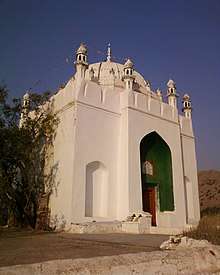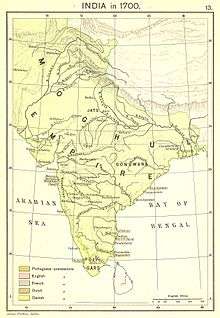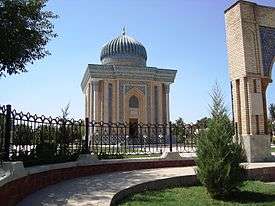Aurangzeb
Muhi-ud-Din Muhammad[3] (3 November 1618 – 3 March 1707),[1] commonly known by the sobriquet Aurangzeb (Persian: "Ornament of the Throne")[3] or by his regnal title Alamgir (Persian: "Conqueror of the World"),[4] was the sixth Mughal emperor, who ruled over almost the entire Indian subcontinent for a period of 49 years.[5][6][7] Widely considered to be the last effective ruler of the Mughal Empire,[8] Aurangzeb compiled the Fatawa-e-Alamgiri, and was among the few monarchs to have fully established Sharia law and Islamic economics throughout the Indian subcontinent.[9][10] He was an accomplished military leader[11] whose rule has been the subject of praise, though he has also been described as the most controversial ruler in Indian history.[12]
| Muhi-ud-din Muhammad Aurangzeb Alamgir محیالدین محمد اورنگزیب عالمگیر | |||||||||
|---|---|---|---|---|---|---|---|---|---|
| Sixth Mughal Emperor Badshah Aurangzeb Alamgir I | |||||||||
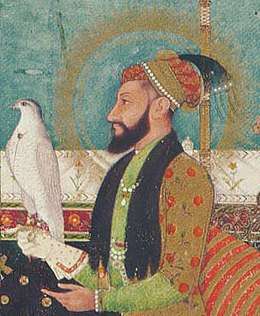 | |||||||||
| 6th Mughal Emperor | |||||||||
| Reign | 31 July 1658 – 3 March 1707 | ||||||||
| Coronation | 13 June 1659 at Shalimar Bagh, Delhi | ||||||||
| Predecessor | Shah Jahan | ||||||||
| Successor | Muhammad Azam Shah (titular) Bahadur Shah I | ||||||||
| Born | Muḥī al-Dīn Muḥammad[1] 4 November 1618 (N.S.) Dahod, Mughal Empire (present-day Gujarat, India) | ||||||||
| Died | 3 March 1707 (N.S.) (aged 88) Ahmednagar, Mughal Empire (present-day Maharashtra, India) | ||||||||
| Burial | |||||||||
| Consort | Dilras Banu Begum[2] | ||||||||
| Wives | |||||||||
| Issue | |||||||||
| |||||||||
| House | Timurid | ||||||||
| Father | Shah Jahan | ||||||||
| Mother | Mumtaz Mahal | ||||||||
| Religion | Sunni Islam | ||||||||
|
||||||||||||||||||||||||||||||||||||||||||
_(cropped).jpg)
He was a notable expansionist; during his reign, the Mughal Empire reached its greatest extent, ruling over nearly all of the Indian subcontinent.[13] During his lifetime, victories in the south expanded the Mughal Empire to 4 million square kilometres,[14] and he ruled over a population estimated to be over 158 million subjects,[13] with an annual revenue of $450 million (more than ten times that of his contemporary Louis XIV of France),[15] or £38,624,680 (2,879,469,894 rupees) in 1690. Under his reign, India surpassed Qing China to become the world's largest economy and biggest manufacturing power, worth nearly a quarter of global GDP and more than the entirety of Western Europe, and its largest and wealthiest subdivision, the Bengal Subah,[16] signaled the proto-industrialization.[17][18][19]
Aurangzeb was noted for his religious piety; he memorized the entire Quran, studied hadiths and stringently observed the rituals of Islam.[20][21] Unlike his predecessors, including his father Shah Jahan, Aurangzeb considered the royal treasury to be held in trust for the citizens of his empire.[21][22] He did not enjoy a luxurious life and his personal expenses and constructions of small mosques were covered by his own earnings, which included the sewing of caps and trade of his written copies of the Quran.[23][24] He also patronized works of Islamic and Arabic calligraphy.[25]
Aurangzeb has been subject to criticism. Critics argue that his policies abandoned his predecessors' legacy of pluralism and religious tolerance, citing his introduction of the jizya tax and other policies based on Islamic ethics, demolition of Hindu temples, the executions of his elder brother Dara Shikoh, Maratha king Sambhaji[26][27] and the ninth Sikh guru Tegh Bahadur,[28][29][lower-alpha 1] and the prohibition and supervision of behaviour and activities that are forbidden in Islam such as music, gambling, fornication, and consumption of alcohol and narcotic.[30][31] Various historians question the historicity of the claims of his critics, arguing that his destruction of temples has been exaggerated,[32][33] and noting that he also built temples,[34] paid for their maintenance,[35] employed significantly more Hindus in his imperial bureaucracy than his predecessors did, and opposed bigotry against Hindus and Shia Muslims.[36]
Early life
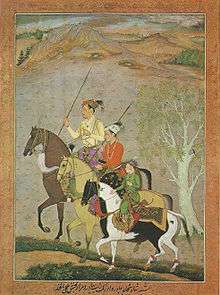
Aurangzeb was born on 3 November 1618, in Dahod, Gujarat. He was the third son and sixth child of Shah Jahan and Mumtaz Mahal.[37] In June 1626, after an unsuccessful rebellion by his father, Aurangzeb and his brother Dara Shukoh were kept as hostages under their grandparents' (Nur Jahan and Jahangir) Lahore court. On 26 February 1628, Shah Jahan was officially declared the Mughal Emperor, and Aurangzeb returned to live with his parents at Agra Fort, where Aurangzeb received his formal education in Arabic and Persian. His daily allowance was fixed at Rs. 500, which he spent on religious education and the study of history.
On 28 May 1633, Aurangzeb escaped death when a powerful war elephant stampeded through the Mughal Imperial encampment. He rode against the elephant and struck its trunk with a lance,[38] and successfully defended himself from being crushed. Aurangzeb's valour was appreciated by his father who conferred him the title of Bahadur (Brave) and had him weighed in gold and presented gifts worth Rs. 200,000. This event was celebrated in Persian and Urdu verses, and Aurangzeb said:[39]
If the (elephant) fight had ended fatally for me, it would not have been a matter of shame. Death drops the curtain even on Emperors; it is no dishonor. The shame lay in what my brothers did!
Early military campaigns and administration
Bundela War
.jpg)
Aurangzeb was nominally in charge of the force sent to Bundelkhand with the intent of subduing the rebellious ruler of Orchha, Jhujhar Singh, who had attacked another territory in defiance of Shah Jahan's policy and was refusing to atone for his actions. By arrangement, Aurangzeb stayed in the rear, away from the fighting, and took the advice of his generals as the Mughal Army gathered and commenced the Siege of Orchha in 1635. The campaign was successful and Singh was removed from power.[40]
Viceroy of the Deccan
_facing_a_maddened_elephant_named_Sudhakar_(7_June_1633).jpg)
Aurangzeb was appointed viceroy of the Deccan in 1636.[42] After Shah Jahan's vassals had been devastated by the alarming expansion of Ahmednagar during the reign of the Nizam Shahi boy-prince Murtaza Shah III, the emperor dispatched Aurangzeb, who in 1636 brought the Nizam Shahi dynasty to an end.[43] In 1637, Aurangzeb married the Safavid princess Dilras Banu Begum, posthumously known as Rabia-ud-Daurani. She was his first wife and chief consort as well as his favourite.[44][45][46] He also had an infatuation with a slave girl, Hira Bai, whose death at a young age greatly affected him. In his old age, he was under the charms of his concubine, Udaipuri Bai. The latter had formerly been a companion to Dara Shukoh.[47] In the same year, 1637, Aurangzeb was placed in charge of annexing the small Rajput kingdom of Baglana, which he did with ease.[20]
In 1644, Aurangzeb's sister, Jahanara, was burned when the chemicals in her perfume were ignited by a nearby lamp while in Agra. This event precipitated a family crisis with political consequences. Aurangzeb suffered his father's displeasure by not returning to Agra immediately but rather three weeks later. Shah Jahan had been nursing Jahanara back to health in that time and thousands of vassals had arrived in Agra to pay their respects. Shah Jahan was outraged to see Aurangzeb enter the interior palace compound in military attire and immediately dismissed him from his position of viceroy of the Deccan; Aurangzeb was also no longer allowed to use red tents or to associate himself with the official military standard of the Mughal emperor. Other sources tell us that Aurangzeb was dismissed from his position because Aurangzeb left the life of luxury and became a Faqir.[48]
In 1645, he was barred from the court for seven months and mentioned his grief to fellow Mughal commanders. Thereafter, Shah Jahan appointed him governor of Gujarat where he served well and was rewarded for bringing stability.
In 1647, Shah Jahan moved Aurangzeb from Gujarat to be governor of Balkh, replacing a younger son, Murad Baksh, who had proved ineffective there. The area was under attack from Uzbek and Turkmen tribes. While the Mughal artillery and muskets were a formidable force, so too were the skirmishing skills of their opponents. The two sides were in stalemate and Aurangzeb discovered that his army could not live off the land, which was devastated by war. With the onset of winter, he and his father had to make a largely unsatisfactory deal with the Uzbeks, giving away territory in exchange for nominal recognition of Mughal sovereignty. The Mughal force suffered still further with attacks by Uzbeks and other tribesmen as it retreated through the snow to Kabul. By the end of this two-year campaign, into which Aurangzeb had been plunged at a late stage, a vast sum of money had been expended for little gain.[49]
Further inauspicious military involvements followed, as Aurangzeb was appointed governor of Multan and Sindh. His efforts in 1649 and 1652 to dislodge the Safavids at Kandahar, which they had recently retaken after a decade of Mughal control, both ended in failure as winter approached. The logistical problems of supplying an army at the extremity of the empire, combined with the poor quality of armaments and the intransigence of the opposition have been cited by John Richards as the reasons for failure, and a third attempt in 1653, led by Dara Shikoh, met with the same outcome.[50]
Aurangzeb became viceroy of the Deccan again after he was replaced by Dara Shukoh in the attempt to recapture Kandahar. Aurangzeb regretted this and harboured feelings that Shikoh had manipulated the situation to serve his own ends. Aurangbad's two jagirs (land grants) were moved there as a consequence of his return and, because the Deccan was a relatively impoverished area, this caused him to lose out financially. So poor was the area that grants were required from Malwa and Gujarat in order to maintain the administration and the situation caused ill-feeling between father and son. Shah Jahan insisted that things could be improved if Aurangzeb made efforts to develop cultivation.[51] Aurangzeb appointed Murshid Quli Khan to extend to the Deccan the zabt revenue system used in northern India. Murshid Quli Khan organised a survey of agricultural land and a tax assessment on what it produced. To increase revenue, Murshid Quli Khan granted loans for seed, livestock, and irrigation infrastructure. The Deccan returned to prosperity,[42][52]
Aurangzeb proposed to resolve the situation by attacking the dynastic occupants of Golconda (the Qutb Shahis) and Bijapur (the Adil Shahis). As an adjunct to resolving the financial difficulties, the proposal would also extend Mughal influence by accruing more lands.[51] Aurangzeb advanced against the Sultan of Bijapur and besieged Bidar. The Kiladar (governor or captain) of the fortified city, Sidi Marjan, was mortally wounded when a gunpowder magazine exploded. After twenty-seven days of hard fighting, Bidar was captured by the Mughals and Aurangzeb continued his advance.[53] Again, he was to feel that Dara had exerted influence on his father: believing that he was on the verge of victory in both instances, Aurangzeb was frustrated that Shah Jahan chose then to settle for negotiations with the opposing forces rather than pushing for complete victory.[51]
War of Succession
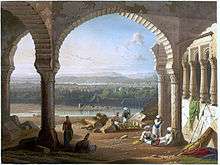
The four sons of Shah Jahan all held governorships during their father's reign. The emperor favoured the eldest, Dara Shukoh.[54] This had caused resentment among the younger three, who sought at various times to strengthen alliances between themselves and against Dara. There was no Mughal tradition of primogeniture, the systematic passing of rule, upon an emperor's death, to his eldest son.[51] Instead it was customary for sons to overthrow their father and for brothers to war to the death among themselves.[55] Historian Satish Chandra says that "In the ultimate resort, connections among the powerful military leaders, and military strength and capacity [were] the real arbiters".[51] The contest for power was primarily between Dara Shikoh and Aurangzeb because, although all four sons had demonstrated competence in their official roles, it was around these two that the supporting cast of officials and other influential people mostly circulated.[56] There were ideological differences — Dara was an intellectual and a religious liberal in the mould of Akbar, while Aurangzeb was much more conservative — but, as historians Barbara D. Metcalf and Thomas R. Metcalf say, "To focus on divergent philosophies neglects the fact that Dara was a poor general and leader. It also ignores the fact that factional lines in the succession dispute were not, by and large, shaped by ideology."[57] Marc Gaborieau, professor of Indian studies at l'École des Hautes Études en Sciences Sociales,[58] explains that "The loyalties of [officials and their armed contingents] seem to have been motivated more by their own interests, the closeness of the family relation and above all the charisma of the pretenders than by ideological divides."[55] Muslims and Hindus did not divide along religious lines in their support for one pretender or the other nor, according to Chandra, is there much evidence to support the belief that Jahanara and other members of the royal family were split in their support. Jahanara, certainly, interceded at various times on behalf of all of the princes and was well-regarded by Aurangzeb even though she shared the religious outlook of Dara.[59]
In 1656, a general under Qutb Shahi dynasty named Musa Khan led an army of 12,000 musketeers to attack Aurangzeb, and later on the same campaign Aurangzeb, in turn, rode against an army consisting 8,000 horsemen and 20,000 Karnataka musketeers.[60]
Having made clear that he wanted Dara to succeed him, Shah Jahan became ill with stranguary in 1657 and was closeted under the care of his favourite son in the newly built city of Shahjahanabad (Old Delhi). Rumours of the death of Shah Jahan abounded and the younger sons were concerned that Dara might be hiding it for Machiavellian reasons. Thus, they took action: Shah Shuja In Bengal, where he had been governor since 1637, Prince Muhammad Shuja crowned himself King at RajMahal, and brought his cavalry, artillery and river flotilla upriver towards Agra. Near Varanasi his forces confronted a defending army sent from Delhi under the command of Prince Sulaiman Shukoh, son of Dara Shukoh, and Raja Jai Singh[61] while Murad did the same in his governorship of Gujarat and Aurangzeb did so in the Deccan. It is not known whether these preparations were made in the mistaken belief that the rumours of death were true or whether the challengers were just taking advantage of the situation.[51]
.jpg)
After regaining some of his health, Shah Jahan moved to Agra and Dara urged him to send forces to challenge Shah Shuja and Murad, who had declared themselves rulers in their respective territories. While Shah Shuja was defeated at Banares in February 1658, the army sent to deal with Murad discovered to their surprise that he and Aurangzeb had combined their forces,[59] the two brothers having agreed to partition the empire once they had gained control of it.[62] The two armies clashed at Dharmat in April 1658, with Aurangzeb being the victor. Shuja was being chased through Bihar and the victory of Aurangzeb proved this to be a poor decision by Dara Shikoh, who now had a defeated force on one front and a successful force unnecessarily pre-occupied on another. Realising that his recalled Bihar forces would not arrive at Agra in time to resist the emboldened Aurangzeb's advance, Dara scrambled to form alliances in order but found that Aurangzeb had already courted key potential candidates. When Dara's disparate, hastily concocted army clashed with Aurangzeb's well-disciplined, battle-hardened force at the Battle of Samugarh in late May, neither Dara's men nor his generalship were any match for Aurangzeb. Dara had also become over-confident in his own abilities and, by ignoring advice not to lead in battle while his father was alive, he cemented the idea that he had usurped the throne.[59] "After the defeat of Dara, Shah Jahan was imprisoned in the fort of Agra where he spent eight long years under the care of his favourite daughter Jahanara."[63]
Aurangzeb then broke his arrangement with Murad Baksh, which probably had been his intention all along.[62] Instead of looking to partition the empire between himself and Murad, he had his brother arrested and imprisoned at Gwalior Fort. Murad was executed on 4 December 1661, ostensibly for the murder of the diwan of Gujarat sometime earlier. The allegation was encouraged by Aurangzeb, who caused the diwan's son to seek retribution for the death under the principles of Sharia law.[64] Meanwhile, Dara gathered his forces, and moved to the Punjab. The army sent against Shuja was trapped in the east, its generals Jai Singh and Dilir Khan submitted to Aurangzeb, but Dara's son, Suleiman Shikoh, escaped. Aurangzeb offered Shah Shuja the governorship of Bengal. This move had the effect of isolating Dara Shikoh and causing more troops to defect to Aurangzeb. Shah Shuja, who had declared himself emperor in Bengal began to annex more territory and this prompted Aurangzeb to march from Punjab with a new and large army that fought during the Battle of Khajwa, where Shah Shuja and his chain-mail armoured war elephants were routed by the forces loyal to Aurangzeb. Shah Shuja then fled to Arakan (in present-day Burma), where he was executed by the local rulers.[65]
With Shuja and Murad disposed of, and with his father immured in Agra, Aurangzeb pursued Dara Shikoh, chasing him across the north-western bounds of the empire. Aurangzeb claimed that Dara was no longer a Muslim and accused him of poisoning the Mughal Grand Vizier Saadullah Khan. After a series of battles, defeats and retreats, Dara was betrayed by one of his generals, who arrested and bound him. In 1658, Aurangzeb arranged his formal coronation in Delhi.
On 10 August 1659, Dara was executed on grounds of apostasy and his head was sent to Shahjahan.[63] Having secured his position, Aurangzeb confined his frail father at the Agra Fort but did not mistreat him. Shah Jahan was cared for by Jahanara and died in 1666.[62]
Reign
Bureaucracy
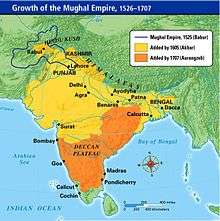
Aurangzeb's imperial bureaucracy employed significantly more Hindus than that of his predecessors. Between 1679 and 1707, the number of Hindu officials in the Mughal administration rose by half, many of them Marathas and Rajputs. His increasing employment of Hindus and Shia Muslims was deemed controversial at the time, with several of his fellow Sunni Muslim officials petitioning against it, which he rejected, and responded, "What connection have earthly affairs with religion? And what right have administrative works to meddle with bigotry? 'For you is your religion and for me is mine." He insisted on employment based on ability rather than religion.[36]
Under Aurangzeb's reign, Hindus rose to represent 31.6% of Mughal nobility, the highest in the Mughal era. This was largely due to a substantial influx of Marathas, who played a key role in his successful Deccan campaign.[66] During his time, the number of Hindu Mansabdars increased from 22% to over 31% in the Mughal administration, as he needed them to continue his fight in the Deccan.[67] However, one of his Rajput nobles, Jaswant Singh of Jodhpur, Hindu ruler of Jodhpur, "destroyed mosques and built idol-temples in their stead" around 1658–1659, according to Aurangzeb. Despite this, relationships did not turn sour between the two, as they worked together for the next two decades up until Singh's death in the late 1670s.[68]
Establishment of Islamic law
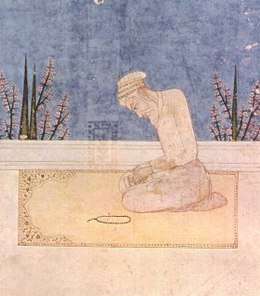
Aurangzeb was an orthodox Muslim ruler. Subsequent to the policies of his three predecessors, he endeavored to make Islam a dominant force in his reign. However these efforts brought him into conflict with the forces that were opposed to this revival.[69]
Historian Katherine Brown has noted that "The very name of Aurangzeb seems to act in the popular imagination as a signifier of politico-religious bigotry and repression, regardless of historical accuracy." The subject has also resonated in modern times with popularly accepted claims that he intended to destroy the Bamiyan Buddhas.[70] As a political and religious conservative, Aurangzeb chose not to follow the secular-religious viewpoints of his predecessors after his ascension. Shah Jahan had already moved away from the liberalism of Akbar, although in a token manner rather than with the intent of suppressing Hinduism,[71][lower-alpha 2] and Aurangzeb took the change still further.[72] Though the approach to faith of Akbar, Jahangir and Shah Jahan was more syncretic than Babur, the founder of the empire, Aurangzeb's position is not so obvious.
His emphasis on sharia competed, or was directly in conflict, with his insistence that zawabit or secular decrees could supersede sharia.[73] The chief qazi refusing to crown him in 1659, Aurangzeb had a political need to present himself as a "defender of the sharia" due to popular opposition to his actions against his father and brothers.[74] Despite claims of sweeping edicts and policies, contradictory accounts exist. Historian Katherine Brown has argued that Aurangzeb never imposed a complete ban on music.[75] He sought to codify Hanafi law by the work of several hundred jurists, called Fatawa-e-Alamgiri.[75] It is possible the War of Succession and continued incursions combined with Shah Jahan's spending made cultural expenditure impossible.[76]
He learnt that at Multan, Thatta, and particularly at Varanasi, the teachings of Hindu Brahmins attracted numerous Muslims. He ordered the subahdars of these provinces to demolish the schools and the temples of non-Muslims.[77] Aurangzeb also ordered subahdars to punish Muslims who dressed like non-Muslims. The executions of the antinomian Sufi mystic Sarmad Kashani and the ninth Sikh Guru Tegh Bahadur bear testimony to Aurangzeb's religious policy; the former was beheaded on multiple accounts of heresy,[lower-alpha 3] the latter, according to Sikhs, because he objected to Aurangzeb's forced conversions.[78][79][80]
Taxation policy
_(cropped).jpg)
He imposed jizya, a military tax on non-Muslims who were not fighting for Mughal Empire in his second decade on ruling in the year 1679.[81] It may be noted that women, children, elders, handicapped, the ill, the insane, monks, hermits, slaves, and musta'mins—non-Muslim foreigners who only temporarily reside in Muslim lands were exempted from the jizya.[82] Further, Aurangzeb levied discriminatory taxes on Hindu merchants at the rate of 5% as against 2.5% on Muslim merchants. He ordered to dismiss Hindu quanungos and patwaris from revenue administration.[67][83][84][85]
The introduction of jizya in 1679 was a response to several events shortly before its introduction: the great Rajput rebellion of 1678, the Maratha alliance with the Shia Golconda, and the Mughal expansion into the Deccan. However, according to Jamal Malik, the contemporary historian Khafi Khan (died 1733), whose family had served Aurangzeb, noted that jizya could not be levied and remained largely a tax on paper only.[67]
Policy on temples and mosques
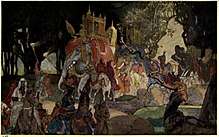
During his reign, Aurangzeb ordered the destruction of many temples and some mosques. For example, he ordered the destruction of Vishvanath Temple at Varanasi for being a centre of conspiracy against the state, and he ordered the destruction of the Jama Masjid at Golkunda[86] after finding out that its ruler had built the mosque in order to hide revenues from the state.
Aurangzeb displayed a particular animus towards Hindus and their temples. In the first volume of his Pulitzer Prize winning book series, historian Will Durant[87] stated the following:
Aurangzeb cared nothing for art, destroyed its "heathen" monuments with coarse bigotry, and fought, through a reign of half a century, to eradicate from India almost all religions but his own. He issued orders to the provincial governors, and to his other subordinates, 'to raze to the ground all the temples of either Hindus or Christians, to smash every idol, and to close every Hindu school. In one year (1679–80) sixty-six temples were broken to pieces in Amber alone, sixtythree at Chitor, one hundred and twenty-three at Udaipur; and over the site of a Benares temple especially sacred to the Hindus he built, in deliberate insult, a Mohammedan mosque. He forbade all public worship of the Hindu faiths, and laid upon every unconverted Hindu a heavy capitation tax. As a result of his fanaticism, thousands of the temples which had represented or housed the art of India through a millennium were laid in ruins. We can never know, from looking at India today, what grandeur and beauty she once possessed. Aurangzeb converted a handful of timid Hindus to Islam, but he wrecked his dynasty and his country. A few Moslems worshiped him as a saint, but the mute and terrorized millions of India looked upon him as a monster, fled from his tax-gatherers, and prayed for his death. During his reign the Mogul empire in India reached its height, extending into the Deccan; but it was a power that had no foundation in the affection of the people, and was doomed to fall at the first hostile and vigorous touch. The Emperor himself, in his last years, began to realize that by the very narrowness of his piety he had destroyed the heritage of his fathers.
Aurangzeb changed the name of one of Hinduism's holiest cities, Benaras, to Muhammadabad.[88] After the Jat rebellion in Mathura, Aurangzeb ordered the city's Kesava Deo temple demolished, and built an Eidgah in its place. In 1679, he ordered destruction of several prominent temples that had become associated with his enemies, including those of Khandela, Udaipur, Chittor and Jodhpur.[89]
Other scholars point out that Aurangzeb also built many temples. Ian Copland says that he built more temples than he destroyed.[34] Ram Puniyani states that Aurangzeb was not fanatically anti-Hindu, but rather continuously adapted his policies depending on circumstances. He banned the construction of new temples, but allowed the repair and maintenance of existing temples, and even made generous donations of jagirs to many temples to gain the goodwill of his Hindu subjects. There are several firmans (orders) in his name, supporting temples and gurudwaras, including Mahakaleshwar temple of Ujjain, Balaji temple of Chitrakoot, Umananda Temple of Guwahati and the Shatrunjaya Jain temples, among others.[90]
Execution of opponents
The first prominent execution during the long reign of Aurangzeb started with that of his brother Prince Dara Shikoh, who was accused of being influenced by Hinduism although some sources argue it was done for political reasons.[91] Aurangzeb had his allied brother Prince Murad Baksh held for murder, judged and then executed.[92] Aurangzeb is accused of poisoning his imprisoned nephew Sulaiman Shikoh.[93]
In 1689, the second Maratha Chhatrapati (King) Sambhaji was brutally executed by Aurangzeb. In a sham trial, he was found guilty of murder and violence, atrocities[94] against the Muslims of Burhanpur and Bahadurpur in Berar by Marathas under his command.[95]
In 1675 the Sikh leader Guru Tegh Bahadur was arrested on orders by Aurangzeb, found guilty of blasphemy by a Qadi's court and executed.[96]
The 32nd Da'i al-Mutlaq (Absolute Missionary) of the Dawoodi Bohra sect of Musta'lī Islam Syedna Qutubkhan Qutubuddin was executed by Aurangzeb, then governor of Gujarat, for heresy; on 27 Jumadil Akhir 1056 AH/ 1648 AD), Ahmedabad, India.[97]
Expansion of the Mughal Empire
In 1663, during his visit to Ladakh, Aurangzeb established direct control over that part of the empire and loyal subjects such as Deldan Namgyal agreed to pledge tribute and loyalty. Deldan Namgyal is also known to have constructed a Grand Mosque in Leh, which he dedicated to Mughal rule.[103]
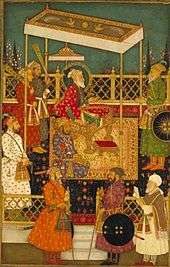
In 1664, Aurangzeb appointed Shaista Khan subedar (governor) of Bengal. Shaista Khan eliminated Portuguese and Arakanese pirates from the region, and in 1666 recaptured the port of Chittagong from the Arakanese king, Sanda Thudhamma. Chittagong remained a key port throughout Mughal rule.[104]
In 1685, Aurangzeb dispatched his son, Muhammad Azam Shah, with a force of nearly 50,000 men to capture Bijapur Fort and defeat Sikandar Adil Shah (the ruler of Bijapur) who refused to be a vassal. The Mughals could not make any advancements upon Bijapur Fort,[105] mainly because of the superior usage of cannon batteries on both sides. Outraged by the stalemate Aurangzeb himself arrived on 4 September 1686 and commanded the Siege of Bijapur; after eight days of fighting, the Mughals were victorious.
Only one remaining ruler, Abul Hasan Qutb Shah (the Qutbshahi ruler of Golconda), refused to surrender. He and his servicemen fortified themselves at Golconda and fiercely protected the Kollur Mine, which was then probably the world's most productive diamond mine, and an important economic asset. In 1687, Aurangzeb led his grand Mughal army against the Deccan Qutbshahi fortress during the Siege of Golconda. The Qutbshahis had constructed massive fortifications throughout successive generations on a granite hill over 400 ft high with an enormous eight-mile long wall enclosing the city. The main gates of Golconda had the ability to repulse any war elephant attack. Although the Qutbshahis maintained the impregnability of their walls, at night Aurangzeb and his infantry erected complex scaffolding that allowed them to scale the high walls. During the eight-month siege the Mughals faced many hardships including the death of their experienced commander Kilich Khan Bahadur. Eventually, Aurangzeb and his forces managed to penetrate the walls by capturing a gate, and their entry into the fort led Abul Hasan Qutb Shah to surrender peacefully.
Military equipment
_of_Emperor_Aurangzeb_(reigned_1658-1707)_and_sheath_LACMA_M.76.2.7a-b_(3_of_9).jpg)
Mughal cannon making skills advanced during the 17th century.[106] One of the most impressive Mughal cannons is known as the Zafarbaksh, which is a very rare composite cannon, that required skills in both wrought-iron forge welding and bronze-casting technologies and the in-depth knowledge of the qualities of both metals.[107]
Aurangzeb military entourage consisted of 16 cannons including the Azdaha Paikar (which, was capable of firing a 33.5 kg ordnance)[108] and Fateh Rahber (20 feet long with Persian and Arabic inscriptions).
The Ibrahim Rauza was also a famed cannon, which was well known for its multi-barrels.[109] François Bernier, the personal physician to Aurangzeb, observed versatile Mughal gun-carriages each drawn by two horses.[110]
Despite these innovations, most soldiers used bows and arrows, the quality of sword manufacture was so poor that they preferred to use ones imported from England, and the operation of the cannons was entrusted not to Mughals but to European gunners. Other weapons used during the period included rockets, cauldrons of boiling oil, muskets and manjaniqs (stone-throwing catapults).[111]
Infantry who were later called Sepoy and who specialised in siege and artillery emerged during the reign of Aurangzeb[112]
- Daulatabad cannon
 Kalak Bangadi cannon.
Kalak Bangadi cannon. One of the Daulatabad cannons
One of the Daulatabad cannons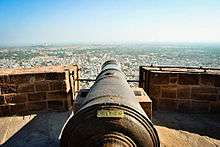 Kilkila cannon
Kilkila cannon- Aurangabad cannon
War elephants
In 1703, the Mughal commander at Coromandel, Daud Khan Panni spent 10,500 coins to purchase 30 to 50 war elephants from Ceylon.[113]
Art and culture
Aurangzeb had a more austere nature than his predecessors, and greatly reduced imperial patronage of the figurative Mughal miniature.[114] This had the effect of dispersing the court atelier to other regional courts. Being religious he encouraged Islamic calligraphy. His reign also saw the building of the Lahore Badshahi Masjid and Bibi Ka Maqbara in Aurangabad for his wife Rabia-ud-Daurani.
Calligraphy
The Mughal Emperor Aurangzeb is known to have patronised works of Islamic calligraphy during his reign particularly Syed Ali Tabrizi.[25]
Architecture
Unlike his father, Aurangzeb was not much interested in architecture. Aurangzeb constructed a small marble mosque known as the Moti Masjid (Pearl Mosque) in the Red Fort complex in Delhi. He ordered the construction of the Badshahi Mosque in Lahore.[116] He also constructed a mosque on Benares. The mosque he constructed in Srinagar is still the largest in Kashmir. The structure of Bibi Ka Maqbara in Aurangabad, which now is a historical monument was constructed by the sons of Aurangzeb in remembrance of their mother. The inspiration came from Taj mahal as is quite visible from its architecture.[117]
Textiles
The textile industry in the Mughal Empire emerged very firmly during the reign of the Mughal Emperor Aurangzeb and was particularly well noted by Francois Bernier, a French physician of the Mughal Emperor. Francois Bernier writes how Karkanahs, or workshops for the artisans, particularly in textiles flourished by "employing hundreds of embroiderers, who were superintended by a master". He further writes how "Artisans manufacture of silk, fine brocade, and other fine muslins, of which are made turbans, robes of gold flowers, and tunics worn by females, so delicately fine as to wear out in one night, and cost even more if they were well embroidered with fine needlework".[118]
He also explains the different techniques employed to produce such complicated textiles such as Himru (whose name is Persian for "brocade"), Paithani (whose pattern is identical on both sides), Mushru (satin weave) and how Kalamkari, in which fabrics are painted or block-printed, was a technique that originally came from Persia. Francois Bernier provided some of the first, impressive descriptions of the designs and the soft, delicate texture of Pashmina Shawls also known as Kani, which were very valued for their warmth and comfort among the Mughals, and how these textiles and shawls eventually began to find their way to France and England.[119]
.jpg) Shawls manufactured in the Mughal Empire had highly influenced other cultures around the world.
Shawls manufactured in the Mughal Empire had highly influenced other cultures around the world..jpg) Shawl makers in the Mughal Empire.
Shawl makers in the Mughal Empire..jpg) Mughal imperial carpet
Mughal imperial carpet
Foreign relations

Aurangzeb sent diplomatic missions to Mecca in 1659 and 1662, with money and gifts for the Sharif. He also sent alms in 1666 and 1672 to be distributed in Mecca and Medina. Historian Naimur Rahman Farooqi writes that, "By 1694, Aurangzeb's ardour for the Sharifs of Mecca had begun to wane; their greed and rapacity had thoroughly disillusioned the Emperor ... Aurangzeb expressed his disgust at the unethical behavior of the Sharif who appropriated all the money sent to the Hijaz for his own use, thus depriving the needy and the poor."[121]
Relations with the Uzbek
Subhan Quli, Balkh's Uzbek ruler was the first to recognise him in 1658 and requested for a general alliance, he worked alongside the new Mughal Emperor since 1647, when Aurangzeb was the Subedar of Balkh.
Relations with the Safavid dynasty
Aurangzeb received the embassy of Abbas II of Persia in 1660 and returned them with gifts. However, relations between the Mughal Empire and the Safavid dynasty were tense because the Persians attacked the Mughal army positioned near Kandahar. Aurangzeb prepared his armies in the Indus River Basin for a counteroffensive, but Abbas II's death in 1666 caused Aurangzeb to end all hostilities. Aurangzeb's rebellious son, Sultan Muhammad Akbar, sought refuge with Suleiman I of Persia, who had rescued him from the Imam of Musqat and later refused to assist him in any military adventures against Aurangzeb.[122]
Relations with the French
In 1667, the French East India Company ambassadors Le Gouz and Bebert presented Louis XIV of France's letter which urged the protection of French merchants from various rebels in the Deccan. In response to the letter, Aurangzeb issued a Firman allowing the French to open a factory in Surat.
 March of the Great Moghul (Aurangzeb)
March of the Great Moghul (Aurangzeb)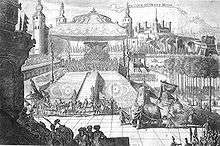 François Bernier, was a French physician and traveller, who for 12 years was the personal physician of Aurangzeb. He described his experiences in Travels in the Mughal Empire.
François Bernier, was a French physician and traveller, who for 12 years was the personal physician of Aurangzeb. He described his experiences in Travels in the Mughal Empire. Map of the Mughal Empire by Vincenzo Coronelli (1650–1718) of Venice, who served as Royal Geographer to Louis XIV of France.
Map of the Mughal Empire by Vincenzo Coronelli (1650–1718) of Venice, who served as Royal Geographer to Louis XIV of France.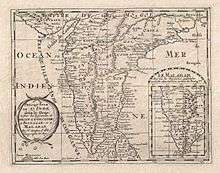 French map of the Deccan.
French map of the Deccan.
Relations with the Sultanate of Maldives
In the 1660s, the Sultan of the Maldives, Ibrahim Iskandar I, requested help from Aurangzeb's representative, the Faujdar of Balasore. The sultan was concerned about the impact of Dutch and English trading ships but the powers of Aurangzeb did not extend to the seas, the Maldives were not under his governance, and nothing came of the request.[123]
Relations with the Ottoman Empire
Like his father, Aurangzeb was not willing to acknowledge the Ottoman claim to the caliphate. He often supported the Ottoman Empire's enemies, extending cordial welcome to two rebel Governors of Basra, and granting them and their families a high status in the imperial service. Sultan Suleiman II's friendly postures were ignored by Aurangzeb.[124] The Sultan urged Aurangzeb to wage holy war against Christians.[125]
Relations with the English and the Child's War
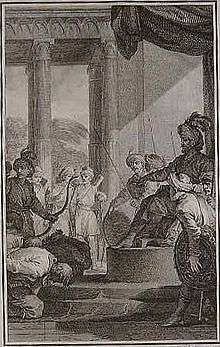
In 1686, the British East India Company, which had unsuccessfully tried to obtain a firman (imperial directive) that would grant England regular trading privileges throughout the Mughal empire, initiated the so-called Child's War.[126] This hostility against the empire ended in disaster for the English, particularly in 1689 when Aurangzeb dispatched a strong fleet of grab ships from Janjira that blockaded Bombay. The ships, commanded by Sidi Yaqub, were manned by Mappila (loyal to Ali Raja Ali II) and Abyssinian sailors.[127] In 1690, the company sent envoys to Aurangzeb's camp to plead for a pardon. The company's envoys had to prostrate themselves before the emperor, pay a large indemnity, and promise better behaviour in the future.
In September 1695, English pirate Henry Every perpetrated one of the most profitable pirate raids in history with his capture of a Grand Mughal grab convoy near Surat. The Indian ships had been returning home from their annual pilgrimage to Mecca when the pirates struck, capturing the Ganj-i-Sawai, reportedly the greatest ship in the Muslim fleet, and its escorts in the process. When news of the piracy reached the mainland, a livid Aurangzeb nearly ordered an armed attack against the English-governed city of Bombay, though he finally agreed to compromise after the East India Company promised to pay financial reparations, estimated at £600,000 by the Mughal authorities.[128] Meanwhile, Aurangzeb shut down four of the East India Company's factories, imprisoned the workers and captains (who were nearly lynched by a rioting mob), and threatened to put an end to all English trading in India until Every was captured.[128] The Privy Council and East India Company offered a massive bounty for Every's apprehension, leading to the first worldwide manhunt in recorded history.[129] However, Every successfully eluded capture.
In 1702, Aurangzeb sent Daud Khan Panni, the Mughal Empire's Subhedar of the Carnatic region, to besiege and blockade Fort St. George for more than three months.[130] The governor of the fort Thomas Pitt was instructed by the East India Company to sue for peace.
Administrative reforms
Tribute
Aurangzeb received tribute from all over the Indian subcontinent, using this wealth to establish bases and fortifications in India, particularly in the Carnatic, Deccan, Bengal and Lahore.
Revenue
Aurangzeb's exchequer raised a record £100 million in annual revenue through various sources like taxes, customs and land revenue, et al. from 24 provinces.[132] He had an annual yearly revenue of $450 million, more than ten times that of his contemporary Louis XIV of France.[15]
Coins
 Half rupee
Half rupee Rupee coin showing full name
Rupee coin showing full name Rupee with square area
Rupee with square area A copper dam of Aurangzeb
A copper dam of Aurangzeb
Aurangzeb felt that verses from the Quran should not be stamped on coins, as done in former times, because they were constantly touched by the hands and feet of people. His coins had the name of the mint city and the year of issue on one face, and, the following couplet on other:[133]
King Aurangzib 'Ālamgir
Stamped coins, in the world, like the bright full moon.[133]
Rebellions
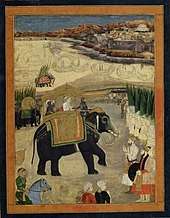
Traditional and newly coherent social groups in northern and western India, such as the Marathas, Rajputs, Hindu Jats, Pashtuns, and Sikhs, gained military and governing ambitions during Mughal rule, which, through collaboration or opposition, gave them both recognition and military experience.[134]
- In 1669, the Hindu Jat peasants of Bharatpur around Mathura rebelled and created Bharatpur state but were defeated.
- In 1659, Shivaji, launched a surprise attack on the Mughal Viceroy Shaista Khan and, while waging war against Aurangzeb. Shivaji and his forces attacked the Deccan, Janjira and Surat and tried to gain control of vast territories. In 1689 Aurangzeb's armies captured Shivaji's son Sambhaji and executed him after he had sacked Burhanpur. But, the Marathas continued the fight and it actually started the terminal decline of his empire.[135]
- In 1679, the Rathore clan under the command of Durgadas Rathore rebelled when Aurangzeb didn't give permission to make the young Rathore prince the king and took direct command of Jodhpur. This incident caused great unrest among the Hindu Rajput rulers under Aurangzeb and led to many rebellions in Rajputana.[136]
- In 1672, the Satnami, a sect concentrated in an area near Delhi, under the leadership of Bhirbhan, took over the administration of Narnaul, but they were eventually crushed upon Aurangzeb's personal intervention with very few escaping alive.[137]
- In 1671, the Battle of Saraighat was fought in the easternmost regions of the Mughal Empire against the Ahom Kingdom. The Mughals led by Mir Jumla II and Shaista Khan attacked and were defeated by the Ahoms.
- Maharaja Chhatrasal was a medieval Indian warrior from Bundela Rajput clan, who fought against the Mughal Emperor Aurangzeb, and established his own kingdom in Bundelkhand, becoming a Maharaja of Panna.[138]
Jat rebellion
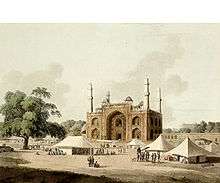
In 1669, Hindu Jats began to organise a rebellion that is believed to have been caused by Aurangzeb's imposition of jizya (a form of organised religious taxation).[139] The Jats were led by Gokula, a rebel landholder from Tilpat. By the year 1670 20,000 Jat rebels were quelled and the Mughal Army took control of Tilpat, Gokula's personal fortune amounted to 93,000 gold coins and hundreds of thousands of silver coins.[140]
Gokula was caught and executed. But the Jats once again attempted began their rebellion. Raja Ram Jat, in order to avenge his father Gokula's death, plundered Akbar's tomb of its gold, silver and fine carpets, opened Akbar's grave and dragged his bones and burned them in retaliation.[141][142][143][144][145] Jats also shot off the tops of the minarets on the gateway to Akbar's Tomb and melted down two silver doors from the Taj Mahal.[146][147][148][149] Aurangzeb appointed Mohammad Bidar Bakht as commander to crush the Jat rebellion. On 4 July 1688, Raja Ram Jat was captured and beheaded. His head was sent to Aurangzeb as proof.[150]
However, after Aurangeb's death Jats under Badan Singh later established their independent state of Bharatpur.
Mughal–Maratha Wars

In 1657, while Aurangzeb attacked Golconda and Bijapur in the Deccan, the Hindu Maratha warrior, Shivaji, used guerrilla tactics to take control of three Adil Shahi forts formerly under his father's command. With these victories, Shivaji assumed de facto leadership of many independent Maratha clans. The Marathas harried the flanks of the warring Adil Shahis, gaining weapons, forts, and territory.[151] Shivaji's small and ill-equipped army survived an all out Adil Shahi attack, and Shivaji personally killed the Adil Shahi general, Afzal Khan.[152] With this event, the Marathas transformed into a powerful military force, capturing more and more Adil Shahi territories.[153] Shivaji went on to neutralise Mughal power in the region.[154]
In 1659, Aurangzeb sent his trusted general and maternal uncle Shaista Khan, the Wali in Golconda to recover forts lost to the Maratha rebels. Shaista Khan drove into Maratha territory and took up residence in Pune. But in a daring raid on the governor's palace in Pune during a midnight wedding celebration, led by Shivaji himself, the Marathas killed Shaista Khan's son and Shivaji maimed Shaista Khan by cutting off three fingers of his hand. Shaista Khan, however, survived and was re-appointed the administrator of Bengal going on to become a key commander in the war against the Ahoms.
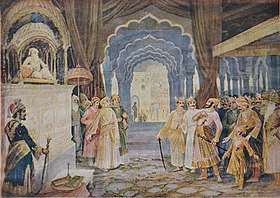
Shivaji captured forts belonging to both Mughals and Bijapur. At last Aurangzeb ordered the armament of the Daulatabad Fort with two bombards (the Daulatabad Fort was later used as a Mughal bastion during the Deccan Wars). Aurangzeb also sent his general Raja Jai Singh of Amber, a Hindu Rajput, to attack the Marathas. Jai Singh won the fort of Purandar after fierce battle in which the Maratha commander Murarbaji fell. Foreseeing defeat, Shivaji agreed for a truce and a meeting with Aurangzeb at Delhi. Jai Singh also promised Shivaji his safety, placing him under the care of his own son, the future Raja Ram Singh I. However, circumstances at the Mughal court were beyond the control of the Raja, and when Shivaji and his son Sambhaji went to Agra to meet Aurangzeb, they were placed under house arrest because of Shivaji's apparent misbehaviour, from which they managed to effect a daring escape.[155]
Shivaji returned to the Deccan, and crowned himself Chhatrapati or the ruler of the Maratha Kingdom in 1674.[156] While Aurangzeb continued to send troops against him, Shivaji expanded Maratha control throughout the Deccan until his death in 1680. Shivaji was succeeded by his son, Sambhaji. Militarily and politically, Mughal efforts to control the Deccan continued to fail.[157]
On the other hand, Aurangzeb's third son Akbar left the Mughal court along with a few Muslim Mansabdar supporters and joined Muslim rebels in the Deccan. Aurangzeb in response moved his court to Aurangabad and took over command of the Deccan campaign. The rebels were defeated and Akbar fled south to seek refuge with Sambhaji, Shivaji's successor. More battles ensued, and Akbar fled to Persia and never returned.[158]
In 1689, Aurangzeb's forces captured and executed Sambhaji. His successor Rajaram, later Rajaram's widow Tarabai and their Maratha forces fought individual battles against the forces of the Mughal Empire. Territory changed hands repeatedly during the years (1689–1707) of interminable warfare . As there was no central authority among the Marathas, Aurangzeb was forced to contest every inch of territory, at great cost in lives and money. Even as Aurangzeb drove west, deep into Maratha territory – notably conquering Satara — the Marathas expanded eastwards into Mughal lands – Malwa and Hyderabad. The Marathas also expanded further South into Southern India defeating the independent local rulers there capturingJinji in Tamil Nadu. Aurangzeb waged continuous war in the Deccan for more than two decades with no resolution.[159] He thus lost about a fifth of his army fighting rebellions led by the Marathas in Deccan India. He travelled a long distance to the Deccan to conquer the Marathas and eventually died at the age of 88, still fighting the Marathas.[160]
Aurangzeb's shift from conventional warfare to anti-insurgency in the Deccan region shifted the paradigm of Mughal military thought. There were conflicts between Marathas and Mughals in Pune, Jinji, Malwa and Vadodara. The Mughal Empire's port city of Surat was sacked twice by the Marathas during the reign of Aurangzeb and the valuable port was in ruins.[161] Matthew White estimates that about 2.5 million of Aurangzeb's army were killed during the Mughal–Maratha Wars (100,000 annually during a quarter-century), while 2 million civilians in war-torn lands died due to drought, plague and famine.[162]
 A Mughal trooper in the Deccan.
A Mughal trooper in the Deccan. Aurangzeb leads his final expedition (1705), leading an army of 500,000 troops.
Aurangzeb leads his final expedition (1705), leading an army of 500,000 troops. Mughal-era aristocrat armed with a matchlock musket.
Mughal-era aristocrat armed with a matchlock musket.
Ahom campaign
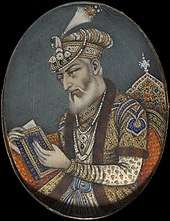
While Aurangzeb and his brother Shah Shuja had been fighting against each other, the Hindu rulers of Kuch Behar and Assam took advantage of the disturbed conditions in the Mughal Empire, had invaded imperial dominions. For three years they were not attacked, but in 1660 Mir Jumla II, the viceroy of Bengal, was ordered to recover the lost territories.[163]
The Mughals set out in November 1661. Within weeks they occupied the capital of Kuch Behar, which they annexed. Leaving a detachment to garrison it, the Mughal army began to retake their territories in Assam. Mir Jumla II advanced on Garhgaon, the capital of the Ahom kingdom, and reached it on 17 March 1662. The ruler, Raja Sutamla, had fled before his approach. The Mughals captured 82 elephants, 300,000 rupees in cash, 1000 ships, and 173 stores of rice.[164]
On his way back to Dacca, in March 1663, Mir Jumla II died of natural causes.[165] Skirmishes continued between the Mughals and Ahoms after the rise of Chakradhwaj Singha, who refused to pay further indemnity to the Mughals and during the wars that continued the Mughals suffered great hardships. Munnawar Khan emerged as a leading figure and is known to have supplied food to vulnerable Mughal forces in the region near Mathurapur. Although the Mughals under the command of Syed Firoz Khan the Faujdar at Guwahati were overrun by two Ahom armies in 1667, but they continued to hold and maintain presence in their eastern territories even after the Battle of Saraighat in 1671.
The Battle of Saraighat was fought in 1671 between the Mughal empire (led by the Kachwaha king, Raja Ramsingh I), and the Ahom Kingdom (led by Lachit Borphukan) on the Brahmaputra river at Saraighat, now in Guwahati. Although much weaker, the Ahom Army defeated the Mughal Army by brilliant uses of the terrain, clever diplomatic negotiations to buy time, guerrilla tactics, psychological warfare, military intelligence and by exploiting the sole weakness of the Mughal forces—its navy.
The Battle of Saraighat was the last battle in the last major attempt by the Mughals to extend their empire into Assam. Though the Mughals managed to regain Guwahati briefly after a later Borphukan deserted it, the Ahoms wrested control in the Battle of Itakhuli in 1682 and maintained it till the end of their rule.[166]
Satnami opposition

In May 1672, the Satnami sect obeying the commandments of an "old toothless woman" (according to Mughal accounts) organised a massive revolt in the agricultural heartlands of the Mughal Empire. The Satnamis were known to have shaved off their heads and even eyebrows and had temples in many regions of Northern India. They began a large-scale rebellion 75 miles southwest of Delhi.[167]
The Satnamis believed they were invulnerable to Mughal bullets and believed they could multiply in any region they entered. The Satnamis initiated their march upon Delhi and overran small-scale Mughal infantry units.[137]
Aurangzeb responded by organising a Mughal army of 10,000 troops and artillery, and dispatched detachments of his own personal Mughal imperial guards to carry out several tasks. To boost Mughal morale, Aurangzeb wrote Islamic prayers, made amulets, and drew designs that would become emblems in the Mughal Army. This rebellion would have a serious aftermath effect on the Punjab.[167]
Sikh opposition
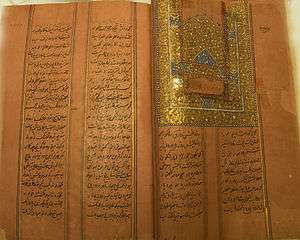
Early in Aurangzeb's reign, various insurgent groups of Sikhs engaged Mughal troops in increasingly bloody battles. The ninth Sikh Guru, Guru Tegh Bahadur, like his predecessors was opposed to conversion of the local population as he considered it wrong. According to Sikh sources, approached by Kashmiri Pandits to help them retain their faith and avoid forced religious conversions, Guru Tegh Bahadur took on Aurangzeb. The emperor perceived the rising popularity of the Guru as a threat to his sovereignty and in 1670 had him executed,[168] which infuriated the Sikhs. In response, Guru Tegh Bahadur's son and successor, Guru Gobind Singh, further militarised his followers, starting with the establishment of Khalsa in 1699, eight years before Aurangzeb's death.[169][170][171] In 1705, Guru Gobind Singh sent a letter entitled Zafarnamah, which accused Aurangzeb of cruelty and betraying Islam.[172][173] The letter caused him much distress and remorse.[174] Guru Gobind Singh's formation of Khalsa in 1699 led to the establishment of the Sikh Confederacy and later Sikh Empire.
Pashtun opposition
.jpg)
The Pashtun revolt in 1672 under the leadership of the warrior poet Khushal Khan Khattak of Kabul,[175][176] was triggered when soldiers under the orders of the Mughal Governor Amir Khan allegedly molested women of the Pashtun tribes in modern-day Kunar Province of Afghanistan. The Safi tribes retaliated against the soldiers. This attack provoked a reprisal, which triggered a general revolt of most of tribes. Attempting to reassert his authority, Amir Khan led a large Mughal Army to the Khyber Pass, where the army was surrounded by tribesmen and routed, with only four men, including the Governor, managing to escape.
Aurangzeb's incursions into the Pashtun areas were described by Khushal Khan Khattak as "Black is the Mughal's heart towards all of us Pathans".[177] Aurangzeb employed the scorched earth policy, sending soldiers who massacred, looted and burnt many villages. Aurangzeb also proceeded to use bribery to turn the Pashtun tribes against each other, with the aim that they would distract a unified Pashtun challenge to Mughal authority, and the impact of this was to leave a lasting legacy of mistrust among the tribes.[178]
After that the revolt spread, with the Mughals suffering a near total collapse of their authority in the Pashtun belt. The closure of the important Attock-Kabul trade route along the Grand Trunk road was particularly disastrous. By 1674, the situation had deteriorated to a point where Aurangzeb camped at Attock to personally take charge. Switching to diplomacy and bribery along with force of arms, the Mughals eventually split the rebels and partially suppressed the revolt, although they never managed to wield effective authority outside the main trade route.
Death
By 1689, the conquest of Golconda, Mughal victories in the south expanded the Mughal Empire to 4 million square kilometres,[14] with a population estimated to be over 158 million.[13] But this supremacy was short-lived.[179] Jos Gommans, Professor of Colonial and Global History at the University of Leiden,[180] says that "... the highpoint of imperial centralisation under emperor Aurangzeb coincided with the start of the imperial downfall."[181]
Unlike his predecessors, Aurangzeb considered the royal treasury to be held in trust for the citizens of his empire. He made caps and copied the Quran to earn money for his use.[23][24] Aurangzeb constructed a small marble mosque known as the Moti Masjid (Pearl Mosque) in the Red Fort complex in Delhi.[182] However, his constant warfare, especially with the Marathas, drove his empire to the brink of bankruptcy just as much as the wasteful personal spending and opulence of his predecessors.[183]
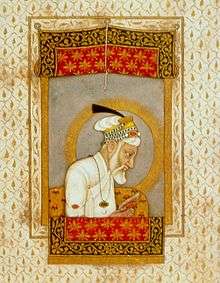
The Indologist Stanley Wolpert, emeritus professor at UCLA,[184] says that:
the conquest of the Deccan, to which Aurangzeb devoted the last 26 years of his life, was in many ways a Pyrrhic victory, costing an estimated hundred thousand lives a year during its last decade of futile chess game warfare. The expense in gold and rupees can hardly be accurately estimated. Aurangzeb's encampment was like a moving capital – a city of tents 30 miles in circumference, with some 250 bazaars, with a 1⁄2 million camp followers, 50,000 camels and 30,000 elephants, all of whom had to be fed, stripped the Deccan of any and all of its surplus grain and wealth ... Not only famine but bubonic plague arose ... Even Aurangzeb, had ceased to understand the purpose of it all by the time he was nearing 90 ... "I came alone and I go as a stranger. I do not know who I am, nor what I have been doing," the dying old man confessed to his son, Azam, in February 1707.[185]
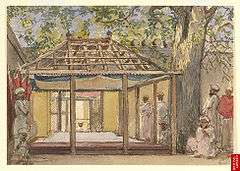
Even when ill and dying, Aurangzeb made sure that the populace knew he was still alive, for if they had thought otherwise then the turmoil of another war of succession was likely.[186] He died at his military camp in Bhingar near Ahmednagar on 20 February 1707 at the age of 89, having outlived many of his children. He had only 300 rupees with him which were later given to charity as per his instructions and he prior to his death requested not to spend extravagantly on his funeral but to keep it simple. [24][187] His modest open-air grave in Khuldabad, Aurangabad, Maharashtra expresses his deep devotion to his Islamic beliefs. It is sited in the courtyard of the shrine of the Sufi saint Shaikh Burhan-u'd-din Gharib, who was a disciple of Nizamuddin Auliya of Delhi.
Many Indian historians consider his death year 1707 as the one which marks the end of Medieval Indian history and the start of Modern Indian history when classifying Indian history. This is because of the start of decline of the Mughal empire and the start of domination of European powers in India.
Brown writes that after his death, "a string of weak emperors, wars of succession, and coups by noblemen heralded the irrevocable weakening of Mughal power". She notes that the populist but "fairly old-fashioned" explanation for the decline is that there was a reaction to Aurangzeb's oppression.[188] Aurangzeb's son, Bahadur Shah I, succeeded him and the empire, both because of Aurangzeb's over-extension and because of Bahadur Shah's weak military and leadership qualities, entered a period of terminal decline. Immediately after Bahadur Shah occupied the throne, the Maratha Empire – which Aurangzeb had held at bay, inflicting high human and monetary costs even on his own empire – consolidated and launched effective invasions of Mughal territory, seizing power from the weak emperor. Within decades of Aurangzeb's death, the Mughal Emperor had little power beyond the walls of Delhi.[189]
Aurangzeb's religious zeal exacted a heavy price both to himself and his nation. Will Durant states:[87]
His deathbed letters are pitiful documents.
I know not who I am, where I shall go, or what will happen to this sinner full of sins. . . . My years have gone by profitless. God has been in my heart, yet my darkened eyes have not recognized his light. . . . There is no hope for me in the future. The fever is gone, but only the skin is left. ... I have greatly sinned, and know not what torments await me. . . . May the peace of God be upon you.He left instructions that his funeral should be ascetically simple, and that no money should be spent on his shroud except the four rupees that he had made by sewing caps. The top of his coffin was to be covered with a plain piece of canvas. To the poor he left three hundred rupees earned by copying the Koran. He died at the age of eighty-nine, having long outstayed his welcome on the earth. Within seventeen years of his death his empire was broken into fragments. The support of the people, so wisely won by Akbar, had been forfeited by the cruelty of Jehangir, the wastefulness of Jehan, and the intolerance of Aurangzeb. The Moslem minority, already enervated by India's heat, had lost the military ardor and physical vigor of their prime, and no fresh recruits were coming from the north to buttress their declining power. Meanwhile, far away in the west, a little island had sent its traders to cull the riches of India. Soon it would send its guns, and take over this immense empire in which Hindu and Moslem had joined to build one of the great civilizations of history.
Legacy
His critics argue that his ruthlessness and religious bigotry made him unsuitable to rule the mixed population of his empire. Some critics assert that the persecution of Shias, Sufis and non-Muslims to impose practices of orthodox Islamic state, such as imposition of sharia and jizya religious tax on non-Muslims, doubling of custom duties on Hindus while abolishing it for Muslims, executions of Muslims and non-Muslims alike, and destruction of temples eventually led to numerous rebellions.[190][191][192][193][194][195] G. N. Moin Shakir and Sarma Festschrift argue that he often used political opposition as pretext for religious persecution,[193] and that, as a result, groups of Jats, Marathas, Sikhs, Satnamis and Pashtuns rose against him.[137][193][196]
Whereas he has his critics, to many he left a positive and lasting legacy, often for the same reasons, notably in Pakistan where author Haroon Khalid writes that "Aurangzeb is presented as a hero who fought and expanded the frontiers of the Islamic empire" and "is imagined to be a true believer who removed corrupt practices from religion and the court, and once again purified the empire."[197] The academic Munis Faruqui also opines that the "Pakistani state and its allies in the religious and political establishments include him in the pantheon of premodern Muslim heroes, especially lauding him for his militarism, personal piety, and seeming willingness to accommodate Islamic morality within state goals."[198]
Muhammad Iqbal, considered the spiritual founder of Pakistan, compared him favorably to the prophet Abraham for his warfare against Akbar's Din-i Ilahi and idolatry,[199] while Iqbal Singh Sevea, in his book on the political philosophy of the thinker, says that "Iqbal considered that the life and activities of Aurangzeb constituted the starting point of Muslim nationality in India."[200] Maulana Shabbir Ahmad Usmani, in his funeral oration, hailed M.A. Jinnah, the founder of Pakistan, to be the greatest Muslim since Aurangzeb.[201] President Zia-ul-Haq, known for his Islamization drive, has been described as "a conceptual descendent of Aurangzeb."[202]
Beyond the individual appreciations, Aurangzeb is seminal to Pakistan's national self-consciousness, as historian Ayesha Jalal, while referring to the Pakistani textbooks controversy, mentions M. D. Zafar's A Text Book of Pakistan Studies where we can read that, under Aurangzeb, "Pakistan spirit gathered in strength", while his death "weakened the Pakistan spirit."[203] Another historian from Pakistan, Mubarak Ali, also looking at the textbooks, and while noting that Akbar "is conveniently ignored and not mentioned in any school textbook from class one to matriculation", contrasts him with Aurangzeb, who "appears in different textbooks of Social Studies and Urdu language as an orthodox and pious Muslim copying the Holy Quran and sewing caps for his livelihood."[204]
This image of Aurangzeb as an Islamic radical isn't limited to Pakistan's official historiography. Historian Audrey Truschke points out that BJP and other Hindu nationalists regard him as Muslim zealot. Nehru claimed that, due to his reversal of the cultural and religious syncretism of the previous Mughal emperors, Aurangzeb acted "more as a Moslem than an Indian ruler".[205]
Full title
Aurangzeb's full imperial title was:
Al-Sultan al-Azam wal Khaqan al-Mukarram Hazrat Abul Muzaffar Muhy-ud-Din Muhammad Aurangzeb Bahadur Alamgir I, Badshah Ghazi, Shahanshah-e-Sultanat-ul-Hindiya Wal Mughaliya.[206]
Aurangzeb had also been attributed various other titles including Caliph of The Merciful, Monarch of Islam, and Living Custodian of God.[9][207]
In literature
Aurangzeb has prominently featured in the following books
- 1675 - Aurang-zebe, play by John Dryden, written and featured on the London stage during the Emperor's lifetime.
- 19?? – Hindi fiction novel by Acharya Chatursen Shastri[208]
- 1970 – Shahenshah (Marathi: शहेनशहा), the Marathi fictional biography by N S Inamdar
- 2017- 1636: Mission to the Mughals, by Eric Flint and Griffin Barber
- 2017 – Shahenshah – The Life of Aurangzeb, the English translation by Vikrant Pande of the 1970 Marathi fictional biography by N S Inamdar
Ancestry
| Ancestors of Aurangzeb | |||||||||||||||||||||||||||||||||||||||||||||||||||||||||||||||||||||||||||||||||||||||||||||||||||||||||||||||||||||||||||||||||||||||||||||||||||||||||||||||||||||||||||||||||||||||||||||||||||||||||||||||||||||||||||||||||||||||||||||||||||||||||||||||||||||||||
|---|---|---|---|---|---|---|---|---|---|---|---|---|---|---|---|---|---|---|---|---|---|---|---|---|---|---|---|---|---|---|---|---|---|---|---|---|---|---|---|---|---|---|---|---|---|---|---|---|---|---|---|---|---|---|---|---|---|---|---|---|---|---|---|---|---|---|---|---|---|---|---|---|---|---|---|---|---|---|---|---|---|---|---|---|---|---|---|---|---|---|---|---|---|---|---|---|---|---|---|---|---|---|---|---|---|---|---|---|---|---|---|---|---|---|---|---|---|---|---|---|---|---|---|---|---|---|---|---|---|---|---|---|---|---|---|---|---|---|---|---|---|---|---|---|---|---|---|---|---|---|---|---|---|---|---|---|---|---|---|---|---|---|---|---|---|---|---|---|---|---|---|---|---|---|---|---|---|---|---|---|---|---|---|---|---|---|---|---|---|---|---|---|---|---|---|---|---|---|---|---|---|---|---|---|---|---|---|---|---|---|---|---|---|---|---|---|---|---|---|---|---|---|---|---|---|---|---|---|---|---|---|---|---|---|---|---|---|---|---|---|---|---|---|---|---|---|---|---|---|---|---|---|---|---|---|---|---|---|---|---|---|---|---|---|---|
| |||||||||||||||||||||||||||||||||||||||||||||||||||||||||||||||||||||||||||||||||||||||||||||||||||||||||||||||||||||||||||||||||||||||||||||||||||||||||||||||||||||||||||||||||||||||||||||||||||||||||||||||||||||||||||||||||||||||||||||||||||||||||||||||||||||||||
See also
- Jaigarh Fort
- Mughal weapons
- List of largest empires
- Muhammad Azam
- Gujarat under Aurangzeb
References
Notes
- See also "Aurangzeb, as he was according to Mughal Records"; more links at the bottom of that page. For Muslim historian's record on major Hindu temple destruction campaigns, from 1193 to 1729 AD, see Richard Eaton (2000), Temple Desecration and Indo-Muslim States, Journal of Islamic Studies, Vol. 11, Issue 3, pages 283–319
- Regarding the tokenistic aspect of Shah Jahan's actions to strengthen Islam in his empire, Satish Chandra says, "We may conclude that Shah Jahan tried to effect a compromise. While formally declaring the state to be an Islamic one, showing respect to the sharia, and observing its injunctions in his personal life, he did not reject any of the liberal measures of Akbar. ... Shah Jahan's compromise was based not on principle but on expediency."[71]
- It has however been argued that the Mughal emperor had political motives for this particular execution. See the article on Sarmad Kashani for references.
Citations
- Spear, Percival. "Aurangzeb". Encyclopædia Britannica. Retrieved 6 April 2016.
- Sarkar, Sir Jadunath (1912). History of Aurangzib Vol. I (PDF). Calcutta: M.C. Sarkar & Sons. p. 61.
- Thackeray, Frank W.; Findling, John E., eds. (2012). Events that formed the modern world : from the European Renaissance through the War on Terror. Santa Barbara, Calif.: ABC-CLIO. p. 248. ISBN 9781598849011.
- Dictionary of Wars. Hoboken: Taylor and Francis. 2013. p. 387. ISBN 9781135954949.
- Chapra, Muhammad Umer (2014). Morality and Justice in Islamic Economics and Finance. Edward Elgar Publishing. pp. 62–63. ISBN 9781783475728.
- Bayly, C.A. (1990). Indian society and the making of the British Empire (1st pbk. ed.). Cambridge [England]: Cambridge University Press. p. 7. ISBN 9780521386500.
- Turchin, Peter; Adams, Jonathan M.; Hall, Thomas D (December 2006). "East-West Orientation of Historical Empires". Journal of World-systems Research. 12 (2): 223. ISSN 1076-156X. Retrieved 12 September 2016.
- Catherine Blanshard Asher, (1992) "Architecture of Mughal India – Part 1", Cambridge university Press, Volume 1, Page 252.
- Hussein, S M (2002). Structure of Politics Under Aurangzeb 1658-1707. Kanishka Publishers Distributors. p. 158. ISBN 978-8173914898.
- Jackson, Roy (2010). Mawlana Mawdudi and Political Islam: Authority and the Islamic State. Routledge. ISBN 9781136950360.
- Balabanlilar, Lisa (2015). Imperial Identity in the Mughal Empire: Memory and Dynastic Politics in Early Modern South and Central Asia. I.B. Tauris. p. 129. ISBN 978-0-85773-246-0.
- Truschke, Audrey (2017). "Chapter 1: Introducing Aurangzeb". Aurangzeb : The Life and Legacy of India's Most Controversial King. Stanford University Press. ISBN 9781503602595. Retrieved 17 November 2018.
Some follow the Indian line that Aurangzeb was a straight-up bigot, whereas others view him as one of the few truly righteous Muslim rulers of old. Precious little history surfaces in these modern visions...Over the centuries, many commentators have spread the myth of the bigoted, evil Aurangzeb on the basis of shockingly thin evidence. Many false ideas still mar popular memory of Aurangzeb, including that he massacred millions of Hindus and destroyed thousands of temples. Neither of these commonly believed "facts" is supported by historical evidence, although some scholars have attempted, usually in bad faith, to provide an alleged basis for such tall tales. More common than bald-faced lies, however, have been biased interpretations of cherry-picked episodes selected with the unabashed goal of supporting a foregone rebuke of Aurangzeb.
- József Böröcz (10 September 2009). The European Union and Global Social Change. Routledge. p. 21. ISBN 9781135255800. Retrieved 26 June 2017.
- Rein Taagepera (September 1997). "Expansion and Contraction Patterns of Large Polities: Context for Russia". International Studies Quarterly. 41 (3): 500. doi:10.1111/0020-8833.00053. JSTOR 2600793.
- Lawrence E. Harrison, Peter L. Berger (2006). Developing cultures: case studies. Routledge. p. 158. ISBN 9780415952798.
- Abhay Kumar Singh (2006). Modern World System and Indian Proto-industrialization: Bengal 1650-1800, (Volume 1). Northern Book Centre. ISBN 9788172112011.
- Maddison, Angus (2003): Development Centre Studies The World Economy Historical Statistics: Historical Statistics, OECD Publishing, ISBN 9264104143, pages 259–261
- Giorgio Riello, Tirthankar Roy (2009). How India Clothed the World: The World of South Asian Textiles, 1500-1850. Brill Publishers. p. 174. ISBN 9789047429975.
- Sanjay Subrahmanyam (1998). Money and the Market in India, 1100–1700. Oxford University Press. ISBN 9780521257589.
- Richards (1996, p. 128)
- Truschke, Audrey (2017). Aurangzeb: The Life and Legacy of India's Most Controversial King. 978-0141001432. ISBN 978-1503602571.
- Eraly, Abraham (2000). Emperors of the Peacock Throne. Penguin. ISBN 978-0141001432.
- Dasgupta, K. (1975). "How Learned Were the Mughals: Reflections on Muslim Libraries in India". The Journal of Library History. 10 (3): 241–254. JSTOR 25540640.
- Qadir, K.B.S.S.A. (1936). "The Cultural Influences of Islam in India". Journal of the Royal Society of Arts. 84 (4338): 228–241. JSTOR 41360651.
- Taher, M. (1994). Librarianship and Library Science in India: An Outline of Historical Perspectives. Concept Publishing Company. p. 54. ISBN 9788170225249. Retrieved 3 October 2014.
- J. L. Mehta (1 January 2005). Advanced Study in the History of Modern India: Volume One: 1707 – 1813. Sterling Publishers Pvt. Ltd. p. 47. ISBN 978-1-932705-54-6. Retrieved 7 April 2016.
- S. B. Bhattacherje (1 May 2009). Encyclopaedia of Indian Events & Dates. Sterling Publishers Pvt. Ltd. pp. A80–A81. ISBN 978-81-207-4074-7. Retrieved 6 March 2012.
- Ayalon, David (1986). Studies in Islamic History and Civilisation. Brill. p. 271. ISBN 978-965-264-014-7.
- Abraham Eraly (2000), Emperors of the Peacock Throne: The Saga of the Great Mughals, Penguin Books, ISBN 978-0141001432, pages 398–399. According to Abraham Eraly, "in 1670, all temples around Ujjain were destroyed" and later "300 temples were destroyed in and around Chitor, Udaipur and Jaipur" among other Hindu temples destroyed elsewhere in campaigns through 1705.
Avari writes, "Aurangzeb's religious policy caused friction between him and the ninth Sikh guru, Tegh Bahadur. In both Punjab and Kashmir the Sikh leader was roused to action by Aurangzeb's excessively zealous Islamic policies. Seized and taken to Delhi, he was called upon by Aurangzeb to embrace Islam and, on refusal, was tortured for five days and then beheaded in November 1675. Two of the ten Sikh gurus thus died as martyrs at the hands of the Mughals. (Avari (2013), page 115) - Haroon, Asif (2004). Muhammad Bin Qasim to General Pervez Musharraf: Triumphs, Tribulations. Lahore: Sang-e-Meel. p. 70. ISBN 978-969-35-1624-1.
To start with, Aurangzeb gradually transformed the system of governance as per the dictates of Shariah ... He curbed evil practices of gambling, drinking and prostitution
- "Mughal dynasty | History, Map, & Facts". Encyclopædia Britannica. Retrieved 6 October 2018.
- Avari 2013, p. 115: citing a 2000 study, writes "Aurangzeb was perhaps no more culpable than most of the sultans before him; they desecrated the temples associated with Hindu power, not all temples. It is worth noting that, in contrast to the traditional claim of hundreds of Hindu temples having been destroyed by Aurangzeb, a recent study suggests a modest figure of just fifteen destructions."
- Audrey Truschke (2017). Aurangzeb: The Life and Legacy of India's Most Controversial King. Stanford University Press. p. 85. ISBN 9781503602595.
Nobody knows the exact number of temples demolished or pillaged on Aurangzeb’s orders, and we never will. Richard Eaton, the leading authority on the subject, puts the number of confirmed temple destructions during Aurangzeb's rule at just over a dozen, with fewer tied to the emperor's direct commands. Other scholars have pointed out additional temple demolitions not counted by Eaton, such as two orders to destroy the Somanatha Temple in 1659 and 1706 (the existence of a second order suggests that the first was never carried out). Aurangzeb also oversaw temple desecrations. For example, in 1645 he ordered mihrabs (prayer niches, typically located in mosques) erected in Ahmedabad's Chintamani Parshvanath Temple, built by the Jain merchant Shantidas. Even adding in such events, however, to quote Eaton, "the evidence is almost always fragmentary, incomplete, or even contradictory". Given this, there were probably more temples destroyed under Aurangzeb than we can confirm (perhaps a few dozen in total?), but here we run into a dark curtain drawn across an unknown past.
- Ian Copland; Ian Mabbett; Asim Roy; Kate Brittlebank; Adam Bowles (2013). A History of State and Religion in India. Routledge. p. 119. ISBN 978-1-136-45950-4.
- B. N. Pande (1996). Aurangzeb and Tipu Sultan: Evaluation of Their Religious Policies. University of Michigan. ISBN 9788185220383.
- Audrey Truschke (2017). Aurangzeb: The Life and Legacy of India's Most Controversial King. Stanford University Press. pp. 50–51. ISBN 9781503602595.
- Waseem, M., ed. (2003). On Becoming an Indian Muslim: French Essays on Aspects of Syncretism. New Delhi: Oxford University Press. p. 103. ISBN 978-0-19-565807-1.
- Schimmel, Annemarie (2004). The empire of the great Mughals. London: Reaktion Books. p. 54. ISBN 978-1-86189-185-3.
- Waldemar Hansen (1 January 1986). The Peacock Throne: The Drama of Mogul India. Motilal Banarsidass. pp. 122–124. ISBN 978-81-208-0225-4. Retrieved 23 November 2012.
- Richards (1996, p. 130)
- Abdul Hamid Lahori (1636). "Prince Awrangzeb (Aurangzeb) facing a maddened elephant named Sudhakar". Padshahnama. Archived from the original on 6 January 2014.
- Markovits, Claude, ed. (2004) [First published 1994 as Histoire de l'Inde Moderne]. A History of Modern India, 1480–1950 (2nd ed.). London: Anthem Press. p. 103. ISBN 978-1-84331-004-4.
- George Michell and Mark Zebrowski, Architecture and Art of the Deccan Sultanates, (Cambridge University Press, 1999), 12.
- Eraly, Abraham (2007). The Mughal World: Life in India's Last Golden Age. Penguin Books India. p. 147. ISBN 978-0-14-310262-5.
- Chandra, Satish (2002) [First published 1959]. Parties and politics at the Mughal Court, 1707–1740 (4th ed.). Oxford University Press. p. 50. ISBN 978-0-19-565444-8.
- Hamid, Annie Krieger Krynicki ; translated from French by Enjum (2005). Captive princess : Zebunissa, daughter of Emperor Aurangzeb. Karachi: Oxford University Press. p. 92. ISBN 9780195798371.
- Brown, Katherine Butler (January 2007). "Did Aurangzeb Ban Music? Questions for the Historiography of his Reign". Modern Asian Studies. 41 (1): 82–84. doi:10.1017/S0026749X05002313.
- Ahmad, Fazl. Heroes of Islam. Lahore: Sh. Muhammad Ashraff, 1993. Print.
- Richards (1996, pp. 132–3)
- Richards (1996, pp. 134–5)
- Chandra, Satish (2005). Medieval India: From Sultanat to the Mughals. 2. Har-Anand Publications. pp. 267–269. ISBN 9788124110669. Retrieved 29 September 2012.
- Richards (1996, pp. 140, 188)
- Prasad, Ishwari (1974). The Mughal Empire. Allahabad: Chugh Publications. pp. 524–525. OCLC 1532660.
[Aurangzeb] marched in the direction of Bijapur and on reaching Bidar laid siege to it ... The Qiladar of the fort was Sidi Marjan ... [The Mughals] were helped by an explosion of powder magazine in the fortress ... Sidi Marjan and two of his sons were badly burnt ... Thus was the fort of Bidar taken after a siege of 27 days ... Sidi Marjan died of his wounds soon afterwards ... Aurangzeb arrived at Kalyani.
- "Aurangzeb and Dara Shikoh's fight for the throne was entwined with the rivalry of their two sisters".
- Markovits, Claude, ed. (2004) [First published 1994 as Histoire de l'Inde Moderne]. A History of Modern India, 1480–1950 (2nd ed.). London: Anthem Press. p. 96. ISBN 978-1-84331-004-4.
- Richards (1996, pp. 151–2)
- Metcalf, Barbara D.; Metcalf, Thomas R. (2006). A Concise History of Modern India (Second ed.). Cambridge: Cambridge University Press. pp. 20–21. ISBN 978-0-521-86362-9.
- "Marc Gaborieau" (in French). Centre d'Études de l'Inde et de l'Asie du Sud. 6 July 2016. Retrieved 2 May 2016.
- Chandra, Satish (2005). Medieval India: From Sultanat to the Mughals. 2. Har-Anand Publications. pp. 270–271. ISBN 9788124110669. Retrieved 29 September 2012.
- Kolff, Dirk H. A. (2002) [First published 1990]. Naukar, Rajput, and Sepoy: The Ethnohistory of the Military Labour Market of Hindustan, 1450–1850 (illustrated, revised ed.). Cambridge University Press. p. 22. ISBN 978-0-521-52305-9.
- Richards (1996, p. 159)
- Chandra, Satish (2005). Medieval India: From Sultanat to the Mughals. 2. Har-Anand Publications. p. 272. ISBN 9788124110669. Retrieved 29 September 2012.
- Sen, Sailendra (2013). A Textbook of Medieval Indian History. Primus Books. p. 183. ISBN 978-9-38060-734-4.
- Richards (1996, p. 162)
- The Cambridge History of India (1922), vol. IV, p. 481.
- Audrey Truschke (2017). Aurangzeb: The Life and Legacy of India's Most Controversial King. Stanford University Press. p. 60. ISBN 9781503602595.
As expected, Aurangzeb’s ascension initially changed little about the Hindu share in Mughal administration. Under Akbar, for example, Hindus were 22.5 percent of all Mughal nobles. That percentage hardly budged in either direction under Shah Jahan, and, in the first twenty-one years of Aurangzeb’s reign (1658–79), it stayed level at 21.6 percent. But between 1679 and 1707 Aurangzeb increased Hindu participation at the elite levels of the Mughal state by nearly 50 percent. Hindus rose to 31.6 percent of the Mughal nobility. This dramatic rise featured a substantial influx of Marathas as a strategic aspect of expanding Mughal sovereignty across the Deccan.
- Islam in South Asia: A Short History By Jamal Malik
- Harbans Mukhia (2015). "As Aurangzeb is Erased, Here are Some Tales From the Flip Side of History". The Wire.
- Holt, P. M.; Lambton, Ann K. S.; Lewis, Bernard, eds. (1977). The Cambridge History of Islam. Cambridge Core. 2a. p. 52. doi:10.1017/chol9780521219488. ISBN 9781139055048.
- Brown, Katherine Butler (January 2007). "Did Aurangzeb Ban Music? Questions for the Historiography of his Reign". Modern Asian Studies. 41 (1): 78. doi:10.1017/S0026749X05002313.
- Chandra, Satish (2005). Medieval India: From Sultanat to the Mughals. 2. Har-Anand Publications. pp. 255–256. ISBN 9788124110669. Retrieved 29 September 2012.
- Richards (1996, p. 171)
- Chandra, Satish (2006) [1999]. Medieval India: From Sultanate To The Mughals: Mughal Empire (1526–1748) (Second Reprint ed.). Har-Anand Publications PVT LTD. p. 350. ISBN 978-8124110669. Retrieved 24 October 2014.
- Satish Chandra (2005). Medieval India: From Sultanat to the Mughals Part - II. Har-Anand Publications. pp. 280–. ISBN 978-81-241-1066-9.
Although Aurangzeb had not raised the slogan of defending Islam before the battle of Samugarh with Dara, and had tried to befriend the Rajput rajas as we have seen, there were a number of factors which make it necessary for Aurangzeb to present himself as the defender of the sharia, and to try and win over the theologians. A principal factor was the popular revulsion against his treatment of his brothers, Murad and Dara, both of whom had the reputation of being liberal patrons of the poor and needy. Aurangzeb was shocked when as the time of his second coronation in 1659, the chief qazi refused to crown him since his father was still alive.
- Brown, Katherine Butler (January 2007). "Did Aurangzeb Ban Music? Questions for the Historiography of his Reign". Modern Asian Studies. 41 (1): 77. doi:10.1017/S0026749X05002313.
More importantly, though, the fact that Aurangzeb did not order a universal ban on music lends support to the idea that his regime was less intolerant and repressive than has been widely believed in the past...Thus, the overwhelming evidence against a ban on musical practice in Aurangzeb's reign suggests that the nature of his state was less orthodox, tyrannical and centralised than
- Zaman, Taymiya R. (2007). Inscribing Empire: Sovereignty and Subjectivity in Mughal Memoirs. University of Michigan. p. 153. ISBN 978-0-549-18117-0.
- Mukhia, Harbans (2004). The Mughals of India. p. 25. ISBN 978-0-631-18555-0.
learnt that in Multan and Thatta in Sind, and especially at Varanasi, Brahmins attracted a large number of Muslims to their discourses. Aurangzeb ... ordered the governors of all these provinces 'to demolish the schools and temples of the infidels'.
- "Religions – Sikhism: Guru Tegh Bahadur". BBC. 1 October 2009. Retrieved 29 April 2012.
- Sadiq Ali (1918), A Vindication of Aurangzeb: In Two Parts, p. 141
- Vipul Singh, The Pearson Indian History Manual for the UPSC Civil Services Preliminary Examination, p. 152, ISBN 9788131717530
- Vinay Lal. "Aurangzeb, Akbar, and the Communalization of History". Manas. Archived from the original on 14 January 2013.
- Aurangzeb, Emperor of Hindustan; Jamshedji Hormasji Bilimoriya (1908). Ruka'at-i-Alamgiri; or, Letters of Aurungzebe, with historical and explanatory notes;. University of California Libraries. London : Luzac [etc., etc.]
- Encyclopedia of World Trade: From Ancient Times to the Present
- A Comprehensive History of Medieval India: Twelfth to the Mid-Eighteenth Century By Farooqui Salma Ahmed
- The Human Journey: A Concise Introduction to World History By Kevin Reilly
- K. Moti Gokulsing; Wimal Dissanayake (2009). Popular Culture in a Globalised India. Routledge. p. 99. ISBN 978-1-134-02307-3.
- Durant (1993, p. 475)
- Goradia, Prafull (2016). The Saffron Book. ISBN 9788128816628.
- Eaton, Richard (2000). "Temple Desecration and Indo-Muslim States". Journal of Islamic Studies. 11 (3): 307–308. doi:10.1093/jis/11.3.283.
In early 1670, soon after the ring-leader of these rebellions had been captured near Mathura, Aurangzeb ordered the destruction of the city's Keshava Deva temple and built an Islamic structure ('īd-gāh) on its site ... Nine years later, the emperor ordered the destruction of several prominent temples in Rajasthan that had become associated with imperial enemies. These included temples in Khandela ... Jodhpur ... Udaipur and Chitor.
- Puniyani, Ram (2003). Communal politics: facts versus myths. SAGE Publications. p. 60. ISBN 978-0-7619-9667-5.
he kept changing his policies depending on the needs of the situation ... he had put a brake on the construction of new temples but the repair and maintenance of old temples was permitted. He also generously donated jagirs to many temples to win the sympathies of the people ... firmans include the ones from the temples of Mahakaleshwar (Ujjain), Balaji temple (Chitrakut), Umanand temples (Guwahati) and Jain temples of Shatrunjaya. Also there are firmans supporting other temples and gurudwaras in north India.
- Gerald James Larson, India's Agony Over Religion, (State University of New York Press, 1995), 111.
- The Cambridge Shorter History of India, Vol. II, ed. H.H. Dodwell, (Cambridge University Press, 1934), 416.
- Vincent Arthur Smith, The Oxford History of India: From the Earliest Times to the End of 1911, (Clarendon Press, 1920), 412.
- Burton Stein, A History of India, ed. David Arnold, (Blackwell Publishers, 1998), 179.
- Richards (1996, p. 223)
- Hardip Singh Syan, Sikh Militancy in the Seventeenth Century: Religious Violence in Mughal and Early Modern India, (I.B. Tauris, 2012), 130–131.
- Blank, Jonah (2001). Mullahs on the Mainframe: Islam and Modernity Among the Daudi Bohras. University of Chicago Press. p. 44. ISBN 9780226056760.
- Burton Stein, A History of India, ed. David Arnold, (Blackwell Publishers, 1998), 179.
- J. L. Mehta (1 January 2005). Advanced Study in the History of Modern India: Volume One: 1707 – 1813. Sterling Publishers Pvt. Ltd. pp. 50–. ISBN 978-1-932705-54-6. Retrieved 29 September 2012.
- Stein, B.; Arnold, D. (2010). A History of India. Wiley. p. 180. ISBN 978-1-4443-2351-1. Retrieved 3 October 2014.
- "A Gateway to Sikhism | Sri Guru Tegh Bhadur Sahib - A Gateway to Sikhism". Archived from the original on 27 March 2014. Retrieved 28 October 2018.
- David Cook, Martyrdom in Islam, (Cambridge University Press, 2007), 80.
- Kaul, H. N. (1998). Rediscovery of Ladakh. Indus Publishing. p. 63. ISBN 9788173870866. Retrieved 29 April 2012.
- Markovits, Claude, ed. (2004) [First published 1994 as Histoire de l'Inde Moderne]. A History of Modern India, 1480–1950 (2nd ed.). London: Anthem Press. p. 106. ISBN 978-1-84331-004-4.
Shayista Khan ... was appointed [Bengal's] governor in 1664 and swept the region clean of Portuguese and Arakanese pirates ... in 1666, he recaptured the port of Chittagong ... from the king of Arakan. A strategic outpost, Chittagong would remain the principal commercial port of call before entering the waters of the delta.
- Farooqui, Salma Ahmed (2011). A Comprehensive History of Medieval India: Twelfth to the Mid-Eighteenth Century. ISBN 9788131732021.
- Singh, Abhay Kumar (2006). Modern World System and Indian Proto-industrialization: Bengal 1650–1800. 1. New Delhi: Northern Book Centre. pp. 351–352. ISBN 9788172112011. Retrieved 30 September 2012.
- Balasubramaniam, R.; Chattopadhyay, Pranab K. (2007). "Zafarbaksh – The Composite Mughal Cannon of Aurangzeb at Fort William in Kolkata" (PDF). Indian Journal of History of Science. 42.
- Roy, K.; Roy, L.D.H.K. (2011). War, Culture and Society in Early Modern South Asia, 1740–1849. Taylor & Francis. p. 30. ISBN 9781136790874. Retrieved 3 October 2014.
- Douglas, James (1893). Bombay and western India: a series of stray papers. 2. Sampson Low, Marston & Company.
- Buchanan, Brenda J. (2006). Gunpowder, Explosives And the State: A Technological History. Ashgate Publishing. p. 59. ISBN 9780754652595.
- Partington, James Riddick (1998) [1960 (Cambridge: W. Heffer & Sons)]. A History of Greek Fire and Gunpowder. Johns Hopkins University Press. p. 221. ISBN 9780801859540.
- Naukar, Rajput, and Sepoy: The Ethnohistory of the Military Labour Market of Hindustan; Dirk H. A. Kolff; Cambridge University Press, 2002 ISBN 9780521523059
- Mughal Warfare: Indian Frontiers and Highroads to Empire, 1500–1700, p. 122, at Google Books
- Imperial Mughal Painting, Stuart Cary Welch, (New York: George Braziller, 1978), pp. 112-13. "In spite of his later austerity, which turned him against music, dance, and painting, a few of the best Mughal paintings were made for [Aurangzeb] 'Alamgir. Perhaps the painters realized that he might close the workshops and therefore exceeded themselves in his behalf".
- "Emirates owner to sell Quran inscribed by Aurangzeb". 15 November 2018.
- Markovits, Claude, ed. (2004) [First published 1994 as Histoire de l'Inde Moderne]. A History of Modern India, 1480–1950 (2nd ed.). London: Anthem Press. p. 166. ISBN 978-1-84331-004-4.
- "World Heritage Sites. Bibi-Ka-Maqbar". Archived from the original on 11 October 2011. Retrieved 28 January 2013.
- Werner, Louis (July–August 2011). "Mughal Maal". Saudi Aramco World. Archived from the original on 22 February 2016. Retrieved 3 October 2014.
- Hansen, Eric (July–August 2002). "Pashmina: Kashmir's Best Cashmere". Saudi Aramco World. Archived from the original on 27 October 2004. Retrieved 3 October 2014.
- Schimmel, A.; Waghmar, B.K. (2004). The Empire of the Great Mughals: History, Art and Culture. Reaktion Books. p. 17. ISBN 9781861891853. Retrieved 3 October 2014.
- Farooqi, Naimur Rahman (1989). Mughal-Ottoman Relations. Delhi: Idarah-i Adabiyat-i Delli. pp. 124, 126. OCLC 20894584.
In November 1659, shortly after his formal coronation, Aurangzeb sent ... a diplomatic mission to Mecca ... entrusted with 630.000 rupees for the Sharif families of Mecca and Medina ... Aurangzeb sent another mission to Mecca in 1662 ... with presents worth 660,000 rupees ... Aurangzeb also sent considerable amount of money, through his own agents, to Mecca. In 1666 ... alms and offerings; ... six years later ... several lakhs of rupees; the money was to be spent in charity in Mecca and Medina.
- Matthee, Rudi (15 December 2011). Persia in Crisis: Safavid Decline and the Fall of Isfahan. pp. 126, 136. ISBN 9781845117450.
- Tripathy, Rasananda (1986). Crafts and commerce in Orissa in the sixteenth-seventeenth centuries. Delhi: Mittal Publications. p. 91. OCLC 14068594. Retrieved 29 April 2012.
- Farooqi, Naimur Rahman (1989). Mughal-Ottoman relations: a study of political & diplomatic relations. Idarah-i Adabiyat-i Delli. pp. 332–333.
Aurangzeb, who seized the Peacock throne from Shahjahan, was equally unwilling to acknowledge the Ottoman claim to the Khilafat. Hostile towards the Ottomans, the Emperor took every opportunity to support the opponents of the Ottoman regime. He cordially welcomed two rebel Governors of Basra and gave them and their dependents high mansabs in the imperial service. Aurangzeb also did not respond to Sultan Suleiman II's friendly overtures.
- Farooqi, Naimur Rahman (1989). Mughal-Ottoman relations: a study of political & diplomatic relations. Idarah-i Adabiyat-i Delli. p. 151. Retrieved 29 April 2012.
Suleiman II even solicited Aurangzeb's support against the Christians and urged him to wage holy war against them.
- "Asia Facts, information, pictures | Encyclopedia.com articles about Asia | Europe, 1450 to 1789: Encyclopedia of the Early Modern World". encyclopedia.com. Retrieved 23 February 2015.
- Faruki, Zahiruddin (1935). Aurangzeb and His times (Reprinted ed.). Bombay: Idarah-i Adabiyāt-i Delli.
- Burgess, Douglas R. (2009). "Piracy in the Public Sphere: The Henry Every Trials and the Battle for Meaning in Seventeenth‐Century Print Culture". Journal of British Studies. 48 (4): 887–913. doi:10.1086/603599.
- Burgess, Douglas R. (2009). The Pirates' Pact: The Secret Alliances Between History's Most Notorious Buccaneers and Colonial America. New York, NY: McGraw-Hill. p. 144. ISBN 978-0-07-147476-4.
- Blackburn, Terence R. (2007). A Miscellany of Mutinies And Massacres in India. APH Publishing. p. 11. ISBN 9788131301692.
- Wilbur, Marguerite Eyer (1951). The East India Company and the British Empire in the Far East. Stanford: Stanford University Press. p. 178. ISBN 9780804728645.
- Hunter, Sir William Wilson (2005) [First published 1886 (London:)]. The Indian Empire: Its People, History, and Products (Reprinted ed.). New Delhi: Asian Educational Services. p. 311. ISBN 9788120615816.
- Khan, Sāqi Must'ad (1947). Maāsir-i-'Ālamgiri: A History of the Emperor Aurangzib 'Ālamgir (reign 1658–1707 A.D.). Translated by Sarkar, Sir Jadunath. Calcutta: Royal Asiatic Society of Bengal. p. 13. OCLC 692517744.
In former times the sacred Quaranic credo (Kalma) used to be stamped on gold and silver coins, and such coins were constantly touched with the hands and feet of men; Aurangzib said that it would be better to stamp some other words ... The Emperor liked it [the couplet] and ordered that one face ... should be stamped with this verse and the other with the name of the mint-city and the year.
- Metcalf, Barbara D.; Metcalf, Thomas R. (2006). A Concise History of Modern India (Second ed.). Cambridge University Press. pp. 23–24. ISBN 978-0-521-86362-9.
- Schmidt, Karl J. (1995). An Atlas and Survey of South Asian History. Armonk, New York: M.E. Sharpe. p. 54. ISBN 9781563243349. Retrieved 29 April 2012.
- Dodwell, Henry H (1962). The Cambridge History of India. pp. 248–252. Retrieved 15 September 2011.
- Edwardes, Stephen Meredyth; Garrett, Herbert Leonard Offley (1930). Mughal Rule in India. Atlantic Publishers and Distributors. p. 119. ISBN 9788171565511.
- Bhagavānadāsa Gupta, Contemporary Sources of the Mediaeval and Modern History of Bundelkhand (1531–1857), vol. 1 (1999). ISBN 81-85396-23-X.
- Avari 2013, p. 131: Crisis arose in the north among the Jat agriculturists dissatisfied with punitive imperial taxation ... The first to rebel against the Mughals were the Hindu Jats.
- Chandra, S. (2005). Medieval India: From Sultanat to the Mughals Part – II. Har-Anand Publications. p. 290. ISBN 9788124110669. Retrieved 3 October 2014.
- Vīrasiṃha, 2006, "The Jats: Their Role & Contribution to the Socio-economic Life and Polity of North & North-west India, Volume 2", University of Michigan, Page 100-102.
- Edward James Rap;son, Sir Wolseley Haig and Sir Richard, 1937, "The Cambridge History of India", Cambridge University Press, Volume 4, pp.305.
- Waldemar Hansen, 1986, "The Peacock Throne: The Drama of Mogul India", Page 454.
- Reddy, 2005, "General Studies History for UPSC", Tata McGraw-Hill, Page B-46.
- Catherine Ella Blanshard Asher, 1992, "Architecture of Mughal India – Part 1", Cambridge university Press, Volume 4, Page 108.
- Peck, Lucy (2008). Agra: The Architectural Heritage. Roli Books. ISBN 978-81-7436-942-0.
- Sir Harry Hamilton Johnston, Leslie Haden Guest, 1937, The World of To-day: The Marvels of Nature and the Creations of Man, Volume 2, p. 510
- Havell, Ernest Binfield (1904). A Handbook to Agra and the Taj, Sikandra, Fatehpur-Sikri and the Neighbourhood. Longmans, Green, and Company. p. 75.
- Penfield, Frederic Courtland (1907). East to Suez Ceylon, India, China, and Japan. p. 179.
- Maasir - I - Alamgiri. 1947.
- Kincaid, Dennis (1937). The Grand Rebel: An Impression of Shivaji, Founder of the Maratha Empire. London: Collins. pp. 72–78.
- Kincaid, Dennis (1937). The Grand Rebel: An Impression of Shivaji Maharaj, Founder of the Maratha Empire. London: Collins. pp. 121–125.
- Kincaid, Dennis (1937). The Grand Rebel: An Impression of Shivaji, Founder of the Maratha Empire. London: Collins. pp. 130–138.
- Markovits, Claude, ed. (2004) [First published 1994 as Histoire de l'Inde Moderne]. A History of Modern India, 1480–1950 (2nd ed.). London: Anthem Press. p. 102. ISBN 978-1-84331-004-4.
- Kincaid, Dennis (1937). The History of Medieviel India:from sultanates to mughals by Satish Chandra. Penguin.
- Kincaid, Dennis (1937). The Grand Rebel: An Impression of Shivaji, Founder of the Maratha Empire. London: Collins. p. 283.
- Agrawal, Ashvini (1983). Studies in Mughal History. Motilal Banarsidass Publication. ISBN 9788120823266.
- Gascoigne, Bamber; Gascoigne, Christina (1971). The Great Moghuls. Cape. pp. 228–229. ISBN 978-0-224-00580-7.
- Gascoigne, Bamber; Gascoigne, Christina (1971). The Great Moghuls. Cape. pp. 239–246. ISBN 978-0-224-00580-7.
- Gordon, Stewart (1993). The Marathas 1600–1818 (1. publ. ed.). New York: Cambridge University. pp. 101–105. ISBN 978-0521268837. Retrieved 20 July 2016.
- Stein, B.; Arnold, D. (2010). A History of India. Wiley. p. 181. ISBN 9781444323511. Retrieved 3 October 2014.
- Matthew White (2011). Atrocitology: Humanity's 100 Deadliest Achievements. Canongate Books. p. 113. ISBN 9780857861252.
- Sarkar, Jadunath, ed. (1973) [First published 1948]. The History of Bengal. Volume II: Muslim Period, 1200-1757. Patna: Academica Asiatica. p. 346. OCLC 924890.
Mir Jumla was appointed governor of Bengal (June 1660) and ordered to punish the kings of Kuch Bihar and Assam.
- Sarkar, Jadunath, ed. (1973) [First published 1948]. The History of Bengal. Volume II: Muslim Period, 1200-1757. Patna: Academica Asiatica. pp. 346–347. OCLC 924890.
[Mir Jumla] left Dacca on 1st November 1661 ... the Mughal army entered the capital of Kuch Bihar on 19th December ... The kingdom was annexed to the Mughal empire ... Mir Jumla set out for the conquest of Assam on 4th January, 1662 ... triumphantly marched into Garh-gaon the Ahom capital on 17th March. Raja Jayadhwaj ... had fled .. The spoils ... 82 elephants, 3 lakhs of rupees in cash, ... over a thousand bots, and 173 stores of paddy.
- Sarkar, Jadunath, ed. (1973) [First published 1948]. The History of Bengal. Volume II: Muslim Period, 1200-1757. Patna: Academica Asiatica. p. 350. OCLC 924890.
[Mir Jumla] set out on his return on 10th January 1663, travelling by pālki owing to his illness, which daily increased. At Baritalā he embarked in a boat and glided down the river toward Dacca, dying on 31st March.
- Sarkar, J. N. (1992), "Chapter VIII Assam-Mughal Relations", in Barpujari, H. K., The Comprehensive History of Assam 2, Guwahati: Assam Publication Board, pp. 148–256
- Hansen, W. (1986). The Peacock Throne: The Drama of Mogul India. Motilal Banarsidass. p. 454. ISBN 9788120802254. Retrieved 3 October 2014.
- Sehgal, Narender (1994). Converted Kashmir: Memorial of Mistakes. Delhi: Utpal Publications. pp. 152–153. ISBN 978-8185217062. Archived from the original on 18 April 2014.
- Arvind-Pal Singh Mandair; Christopher Shackle; Gurharpal Singh (2013). Sikh Religion, Culture and Ethnicity. Routledge. pp. 25–28. ISBN 978-1-136-84627-4.
- "BBC Religions - Sikhism". BBC. 26 October 2009. Retrieved 30 July 2011.
- P Dhavan (2011). When Sparrows Became Hawks: The Making of the Sikh Warrior Tradition, 1699–1799. Oxford University Press. pp. 3–4. ISBN 978-0-19-975655-1.
- Chaitanya, Krishna (1994). A History of Indian Painting: The Modern Period. Abhinav Publications. pp. 3–4. ISBN 978-81-7017-310-6.
In the letter to Aurangzeb in his Zafarnama, Gobind Singh opposes the emperor not because he is a Muslim, but condemns him because he had betrayed Islam by his deceit, unscrupulousness and intolerance. 'You, who profess belief in the one God and the Koran do not have at heart an atom of faith in them... You neither recognise any God, nor do you have any respect for Prophet Mohammed.'
- Randhawa, Karenjot (2012). Civil Society in Malerkotla, Punjab: Fostering Resilience Through Religion. Lexington Books. p. 61. ISBN 9780739167373.
- Renard, John (2012). Fighting Words: Religion, Violence, and the Interpretation of Sacred Texts. University of California Press. p. 215. ISBN 9780520274198.
- Morgenstierne, G. (1960). "Khushhal Khan—the national poet of the Afghans". Journal of the Royal Central Asian Society. 47: 49–57. doi:10.1080/03068376008731684.
- Banting, Erinn (2003). Afghanistan: The Culture Lands, Peoples, & Cultures. Crabtree Publishing Company. p. 28. ISBN 978-0778793373. Retrieved 28 February 2013.
- Sugata Bose; Ayesha Jalal (7 September 2017). Modern South Asia: History, Culture, Political Economy. Taylor & Francis. pp. 80–. ISBN 978-1-351-60305-8.
'Black is the Mughal's heart towards all us Pathans', complained the Pushto poet Khushal Khan Khattak about Aurangzeb's incursions in the tribal regions of the northwest frontier of India.
- Omrani, Bijan (July 2009). "The Durand Line: History and Problems of the Afghan-Pakistan Border". Asian Affairs. XL: 182.
The situation deteriorated and matters came to a head in 1675, at the time of the last great Mughal Emperor, Aurangzeb. He launched a terrible scorched earth policy, sending thousands of soldiers into the valleys, burning, despoiling, smashing villages and killing as many tribesmen as possible. He also successfully used bribery to set the tribal chiefs against each other, thus fomenting so much mutual suspicion that they were too busy fighting each other to fight the Mughal Empire. This worked up to a point. But the resulting legacy of mistrust between the tribes destroyed any prospect that unified political institutions might slowly emerge or that the laws and government of the settled regions might be adopted.
- Richards (1996, p. 1)
- "Prof.dr. J.J.L. (Jos) Gommans". Universiteit Leiden. 14 August 2012. Retrieved 30 September 2012.
- Gommans, Jos J. L. (2002). Mughal Warfare: Indian Frontiers and Highroads to Empire 1500–1700. London: Routledge. p. 16. ISBN 9780415239899. Retrieved 30 September 2012.
- Murray, John (1911). A handbook for travelers in India, Burma and Ceylon (8th ed.). Calcutta: Thacker, Spink, & Co. p. 198. ISBN 978-1175486417. Retrieved 25 January 2014.
- Richards, J. F. (1981). "Mughal State Finance and the Premodern World Economy". Comparative Studies in Society and History. 23 (2): 285–308. doi:10.1017/s0010417500013311. JSTOR 178737.
- "Stanley A. Wolpert". UCLA. Archived from the original on 30 September 2012. Retrieved 1 October 2012.
- Wolpert, Stanley A. (2004) [1977]. New History of India (7th ed.). Oxford: Oxford University Press. ISBN 9780195166774.
- Braudel, Fernand (1992) [1979 (Paris: Librairie Armand Colin: Le Temps du Monde)]. Civilization and Capitalism: 15th–18th Century: The Perspective of the World. III. Berkeley & Los Angeles: University of California Press. p. 514. ISBN 9780520081161. Retrieved 30 September 2012.
- Sohoni, P., 2016. A Tale of Two Imperial Residences: Aurangzeb's Architectural Patronage. Journal of Islamic Architecture, 4(2), pp.63-69.
- Brown, Katherine Butler (January 2007). "Did Aurangzeb Ban Music? Questions for the Historiography of his Reign". Modern Asian Studies. 41 (1): 79. doi:10.1017/S0026749X05002313.
- Mehta, Jaswant (2005). Advanced Study in the History of Modern India 1707–1813. Elgin Ill, USA: New Dawn Press. p. 141. ISBN 978-1-932705-54-6.
- Pletcher, Kenneth, ed. (2010). The History of India. Britannica Educational Publishing. p. 183. ISBN 978-1-61530-201-7.
- Joseph, Paul, ed. (2016). The SAGE Encyclopedia of War: Social Science Perspectives. SAGE Publications. pp. 432–433. ISBN 978-1-4833-5988-5.
- Gupta, R.K.; Bakshi, S.R. (2008). Dalit Literature: Our Response. Sarup & Sons. p. 77. ISBN 978-81-7625-841-8.
- Shakir, Moin, ed. (1989). Religion State And Politics in India. Ajanta Publications (India). p. 47. ISBN 978-81-202-0213-9.
- Upshur, Jiu-Hwa L.; Terry, Janice J.; Holoka, Jim (2011). Cengage Advantage Books: World History. Cengage Learning. p. 527. ISBN 978-1-111-34514-3.
- Amy Chua, 2009, "Day of Empire: How Hyperpowers Rise to Global Dominance—and Why They Fall.", Anchor Books, p. 189.
- Ashvini Agrawal, 1983, "Studies in Mughal History.", p. 15.
- Haroon Khalid (1 October 2018), "In India and Pakistan, religion makes one country’s hero the other’s villain", Quartz India. Retrieved 21 April 2019.
- Munis D. Faruqui "Book review of Aurangzeb: The Life and Legacy of India’s Most Controversial King" in Journal of the American Academy of Religion, Volume 87, Issue 1, March 2019, p. 300
- Sisir Kumar Das, History of Indian Literature: 1911-1956, struggle for freedom : triumph and tragedy, Sahitya Akademi (2005), p. 368
- Iqbal Singh Sevea, The Political Philosophy of Muhammad Iqbal: Islam and Nationalism in Late Colonial India, Cambridge University Press (2012), p. 168
- Venkat Dhulipala, Creating a New Medina: State Power, Islam, and the Quest for Pakistan in Late Colonial North India, Cambridge University Press (2015), p. 489
- Pakistan Journal of History and Culture, vol. 13 (1996), p. 116
- Ayesha Jalal, "Conjuring Pakistan: History as Official Imagining" in International Journal of Middle East Studies, Vol. 27, No. 1 (Feb., 1995), p. 79
- Mubarak Ali, "Akbar in Pakistani Textbooks" in Social Scientist, Vol. 20, No. 9/10 (Sep. - Oct., 1992), p. 73
- Audrey Truschke, Aurangzeb: The Life and Legacy of India's Most Controversial King, Stanford University Press (2017), p. 7
- "Tomb of Aurangzeb" (PDF). ASI Aurangabad. Retrieved 21 March 2015.
- Shah Muhammad Waseem (2003): هندوستان ميں فارسى تاريخ نگارى: ٧١ويں صدى كے آخرى نصف سے ٨١ويں صدى كے پهلے نصف تک فارسى تاريخ نگارى كا ارتقاء, Kanishka Publishing, original source from the University of Michigan ISBN 9788173915376
- Lokapally, Vijay (21 June 2016). "Understanding Aurangzeb". The Hindu. ISSN 0971-751X. Retrieved 13 December 2017.
- Mehta (1986, p. 374)
- Mehta, Jl (1986). Advanced Study in the History of Medieval India. p. 418.
- Kobita Sarker, Shah Jahan and his paradise on earth: the story of Shah Jahan's creations in Agra and Shahjahanabad in the golden days of the Mughals (2007), p. 187
- Soma Mukherjee, Royal Mughal Ladies and Their Contributions (2001), p. 128
- Subhash Parihar, Some Aspects of Indo-Islamic Architecture (1999), p. 149
- Frank W. Thackeray, John E. Findling, Events That Formed the Modern World (2012), p. 254
- Shujauddin, Mohammad; Shujauddin, Razia (1967). The Life and Times of Noor Jahan. Caravan Book House. p. 1.
- Ahmad, Moin-ud-din (1924). The Taj and Its Environments: With 8 Illus. from Photos., 1 Map, and 4 Plans. R. G. Bansal. p. 101.
Bibliography
- Avari, Burjor (2013), Islamic Civilization in South Asia: A History of Muslim Power and Presence in the Indian Subcontinent, Routledge, ISBN 978-0-41558-061-8
- Durant, Will (1993) [First published 1935]. The Story of Civilization: Our Oriental Heritage. Simon & Schuster. ISBN 978-1-56731-023-8.
- Richards, John F. (1996) [First published 1993]. The Mughal Empire. The New Cambridge History of India. 5. Cambridge University Press. ISBN 978-0-521-56603-2.
Further reading
- Eraly, Abraham (2007). The Mughal world. London: Weidenfeld & Nicolson. ISBN 9780297852094.
- Hansen, Waldemar (1986) [1972 (Holt, Rinehart, Winston)]. The Peacock Throne: The Drama of Mogul India (Second ed.). Motilal Banarsidass. ISBN 9788120802254.
- Muḥammad Bakhtāvar Khān. Mir'at al-'Alam: History of Emperor Awangzeb Alamgir. Trans. Sajida Alvi. Lahore: Idārah-ʾi Taḥqīqāt-i Pākistan, 1979.
- Khan, Khafi (2006) [1718]. Hashim, Muhammad (ed.). Muntakhab-ul Lubab. Pakistan: Sang-e-Meel Publications.
- Kruijtzer, Gijs (2009). Xenophobia in Seventeenth-century India. Leiden University Press. ISBN 9789087280680.
- Sarkar, Jadunath (1972). History of Aurangzib. Bombay: Orient Longman.
- Delhi, Khushwant Singh, Penguin USA, Open Market Ed edition, 5 February 2000. (ISBN 0-14-012619-8)
- Truschke, Audrey (2017). Aurangzeb: The Man and The Myth. Penguin India. ISBN 9781503602595. Also published as Truschke, Audrey (2017). Aurangzeb: The Life and Legacy of India's Most Controversial King. Stanford University Press. ISBN 9781503602595.
- A Short History of Pakistan, Dr. Ishtiaque Hussain Qureshi, University of Karachi Press.
External links
| Wikiquote has quotations related to: Aurangzeb |
| Wikimedia Commons has media related to: |
- Aurangzeb, as he was according to Mughal Records
- Article on Aurganzeb from MANAS group page, UCLA
- by Audrey Truschke, published on AEON
- The Tragedy of Aureng-zebe Text of John Dryden's drama, based loosely on Aurangzeb and the Mughal court, 1675
- Coins of Aurangzeb
- Life of Auranzeb in Urdu (ebook)
Aurangzeb Timurid Dynasty Born: 4 November 1618 Died: 3 March 1707 | ||
| Regnal titles | ||
|---|---|---|
| Preceded by Shah Jahan |
Mughal Emperor 1658–1707 |
Succeeded by Bahadur Shah I |

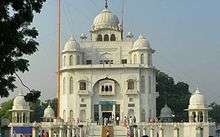
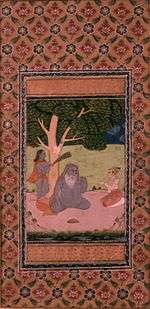
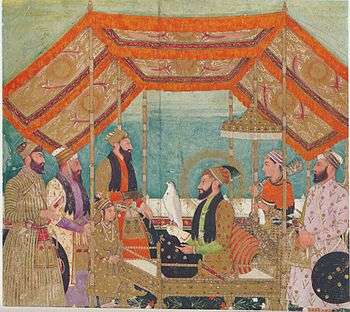


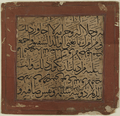


.jpg)

